With the adoption of electric cars only accelerating as manufacturers put more and more money behind them, as ZEV mandate legislation pushes their adoption ever harder, and as customers move in greater and greater numbers to trade in their combustion-engined cars in favour of them, one main barrier to ownership looms in the minds of those unsure whether an EV will meet their needs: the charging question.
How and where will I charge? How long will it take? And is the infrastructure in place?
For most owners who’ve already adopted, and many of those still to, home charging is and will remain key to making an EV practical. But for plenty of others, home charging will never be possible, and urban charging infrastructure on residential streets is proving slow to appear.
Public DC rapid charging, then, will remain critically important for a great many, and for a considerable time to come. But even now, there are big differences in the rate at which one electric car may be capable of charging, out in the real world and away from the spec sheet, compared with another. So how fast can new EVs charge right now, assuming you find the right charger? And which are the quickest?
Since the autumn of 2022, Autocar has been benchmark testing the rapid-charge performance of all electric cars that undergo our full road test, and below you can see the results. They reveal several important facts: that true charging speed can be a far cry from any car’s claimed peak rate, when you calculate an average across the full breadth of available battery capacity. Also, that the rate of rapid charge of all EVs should be expected to slow down considerably as their batteries fill up. Some cars, however, slow considerably more than others.
How we test electric car charging speeds
Our approach to our rapid charge test is simply to use a rapid charger of sufficient capacity to meet the test car’s peak charging rate; and to observe and record how much power is actually drawn by the car as it passes a 10%, 30%, 50%, 70% and 90% state of charge (SOC).
Practicability dictates that we cannot use the same DC charger for every test and, while we pre-condition the car’s battery before charging where possible, many EVs don’t allow this once battery condition has dropped below 10%.
We then average our test results with a weighting that reflects the need that rapid charging typically meets for EV drivers. Public rapid charging is relatively expensive compared with home charging. Most use it to extend the range of their cars for a particular journey, rather than as a regular habit, and as a result few rapid charge from less than 20% charge, or to beyond 80% (because doing that isn’t time-efficient or beneficial to battery longevity).
For that reason, the rapid charge rate demonstrated by a new car as it passes 50% SOC contributes three times as much towards our aggregated charge rate result as the equivalent rate indicated at either 10% or 90%; and likewise, the rates recorded at 70% and 30% are doubly important as those at the extremes of the battery condition spectrum.
So, would you expect one of the best-value electric cars in Britain to appear within the top half of this list? Would you expect to see a top three without a Tesla in it? Here are the quickest- and slowest-charging electric cars that Autocar has yet road tested.
1. Porsche Taycan GTS Sport Turismo (2023)
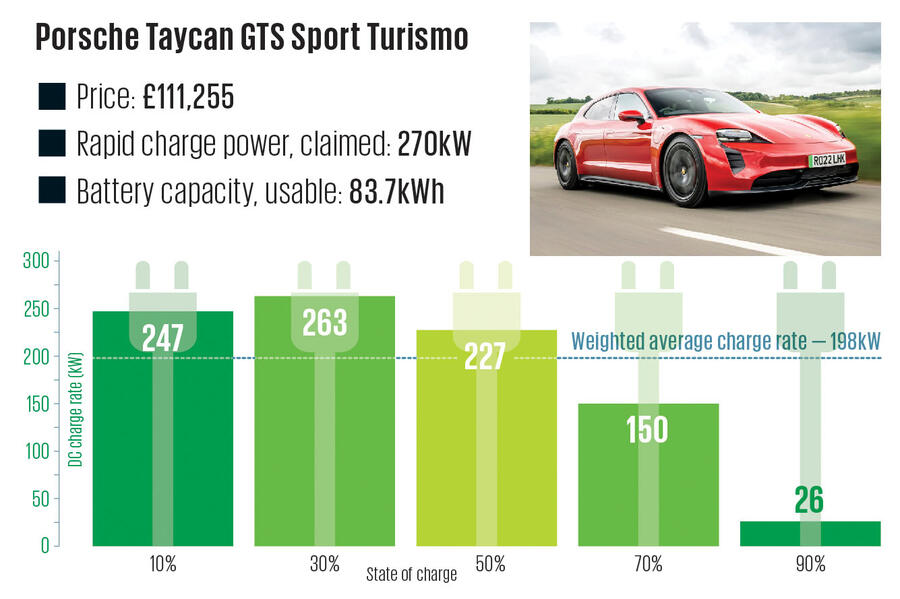
Claimed peak rate: 270kW
Peak rate on test: 263kW
Average test charge rate: 198kW
Usable battery capacity: 83.7kWh
Test charger: Ads-tec/Porsche Engineering HBD 1120, operated by Porsche
Test charge conditions: dry, 22deg C
Porsche Taycan GTS Sport Turismo review
2. Audi E-tron GT Vorsprung (2023)
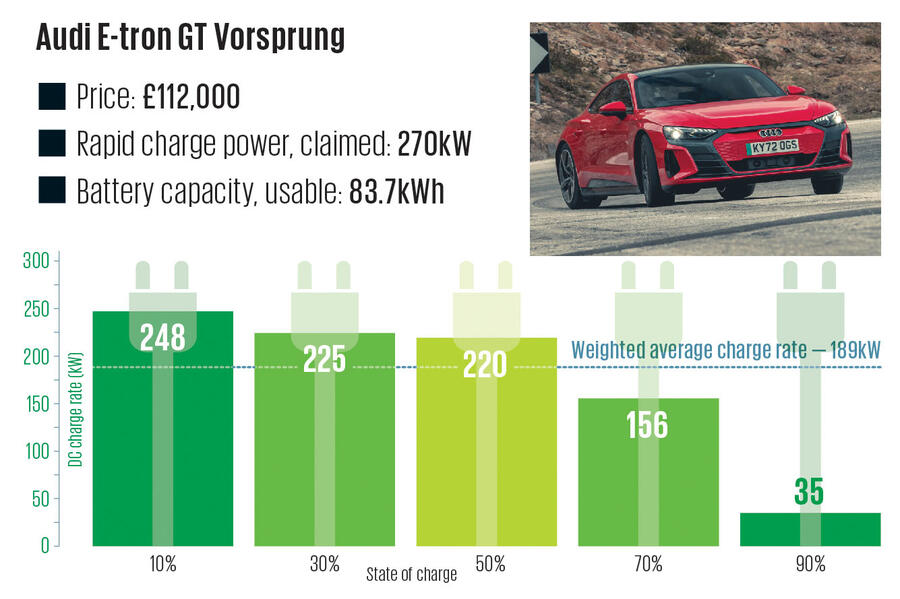
Claimed peak rate: 270kW
Peak rate on test: 248kW
Average test charge rate: 189kW
Usable battery capacity: 83.7kWh
Test charger: Tritium TRI 121-350, operated by Gridserve
Test charge conditions: dry, 7deg C
3. Hyundai Ioniq 6 RWD Ultimate (2023)
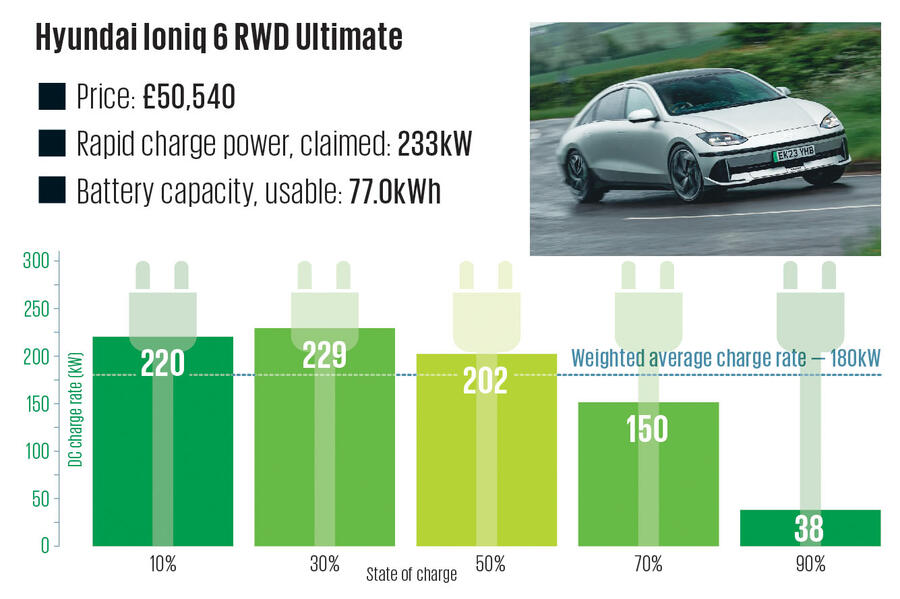
Claimed peak rate: 233kW
Peak rate on test: 229kW
Average test charge rate: 180kW
Usable battery capacity: 77.4kWh
Test charger: Tritium TRI 121-350, operated by Gridserve
Test charge conditions: dry, 13deg C
4. Kia EV9 GT-Line S
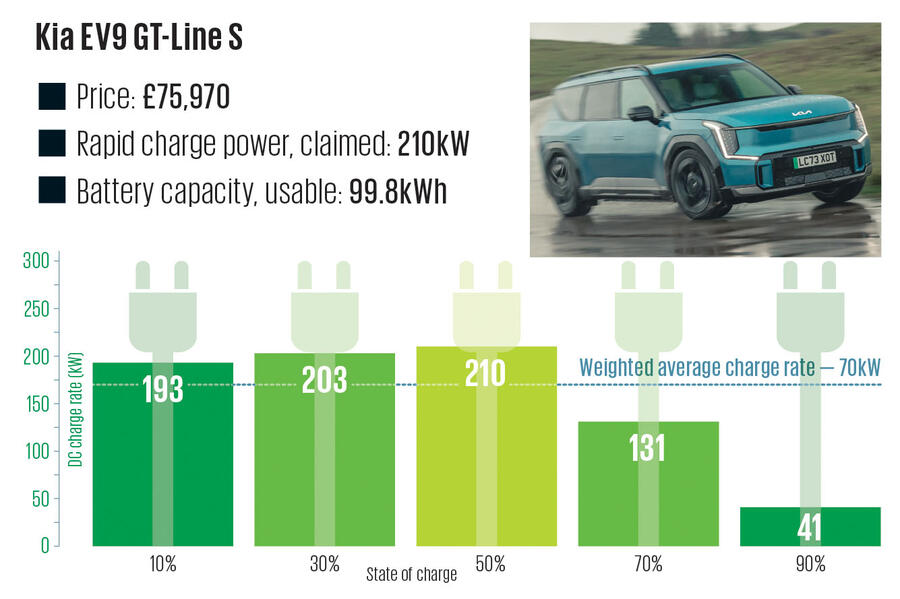
Claimed peak rate: 210kW
Peak rate on test: 210kW
Average test charge rate: 170kW
Usable battery capacity: 99.8kWh
Test charger: Kempower Satellite Charger, 400kW
Test charge conditions: dry, 12deg C
5. Kia EV6 GT
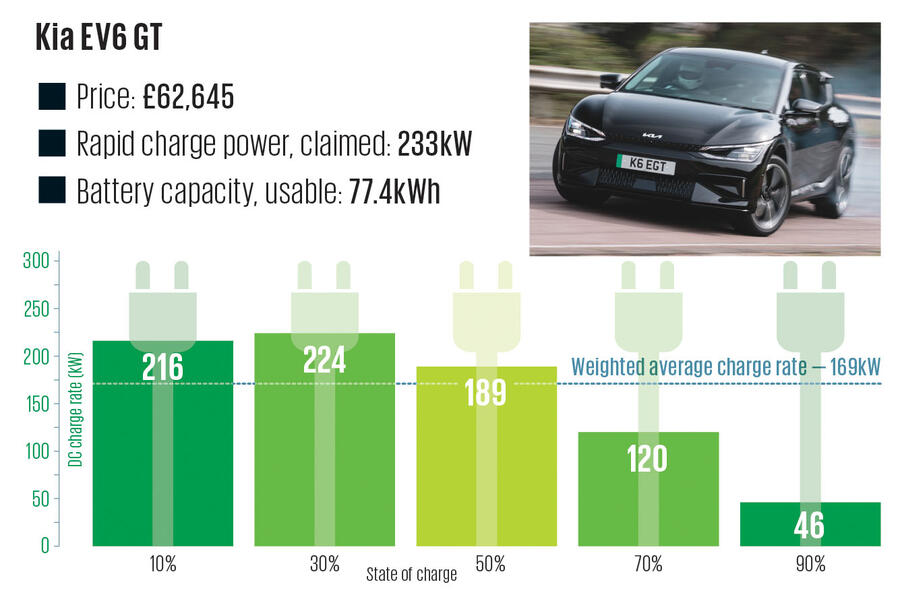
Claimed peak rate: 350kW
Peak rate on test: 224kW
Average test charge rate: 169kW
Usable battery capacity: 77.4kWh
Test charger: Tritium TRI121-350, operated by Gridserve
Test charge conditions: dry, 30deg C
6. Tesla Model S Plaid
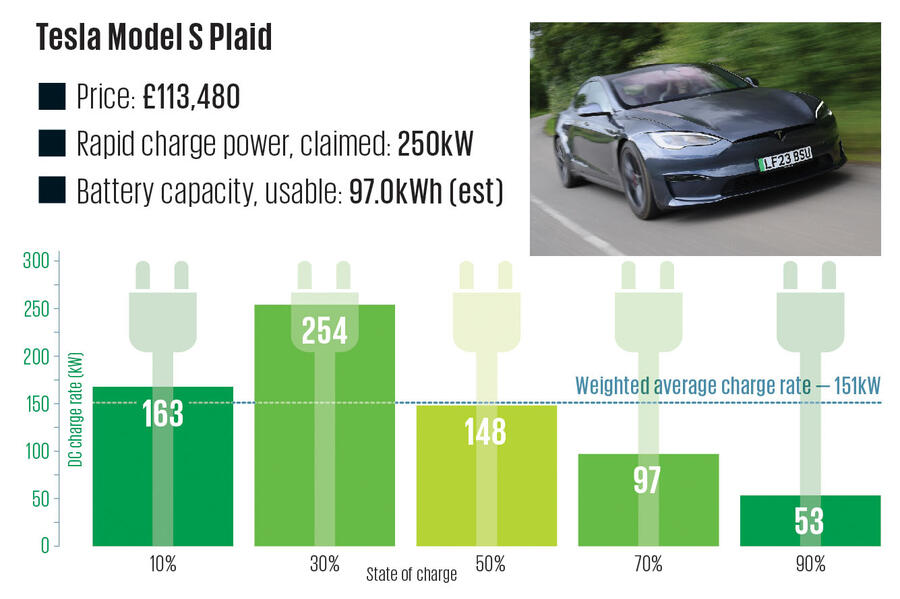
Claimed peak rate: 250kW
Peak rate on test: 254kW
Average test charge rate: 151kW
Usable battery capacity: 97kWh (est)
Test charger: Tesla Supercharger V3
Test charge conditions: dry, 18deg C
7. BMW i7 xDrive60 M Sport (2023)
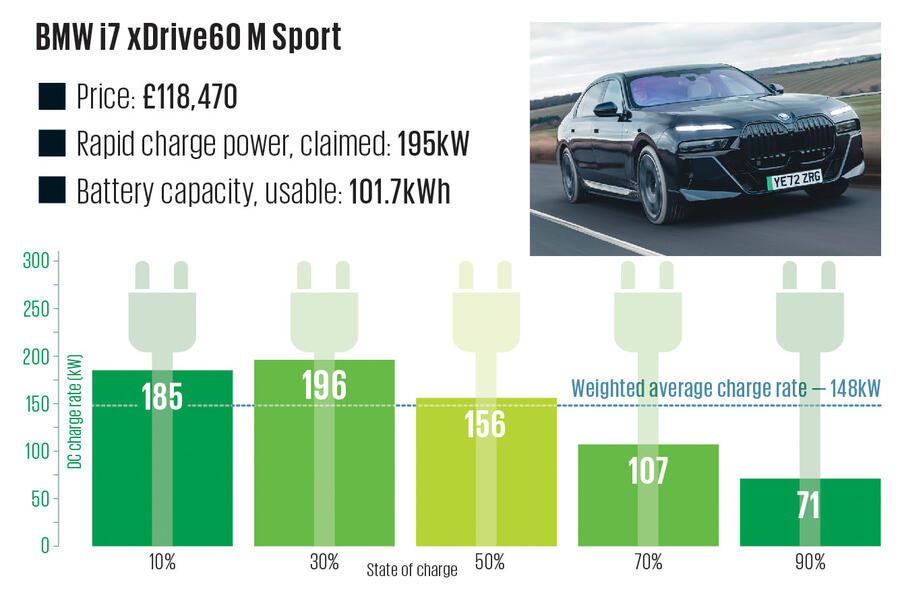
Claimed peak rate: 195kW
Peak rate on test: 196kW
Average test charge rate: 148kW
Usable battery capacity: 101.7kWh
Test charger: Tritium TRI 121-350, operated by Gridserve
Test charge conditions: dry, 8deg C
8. Rolls-Royce Spectre (2023)
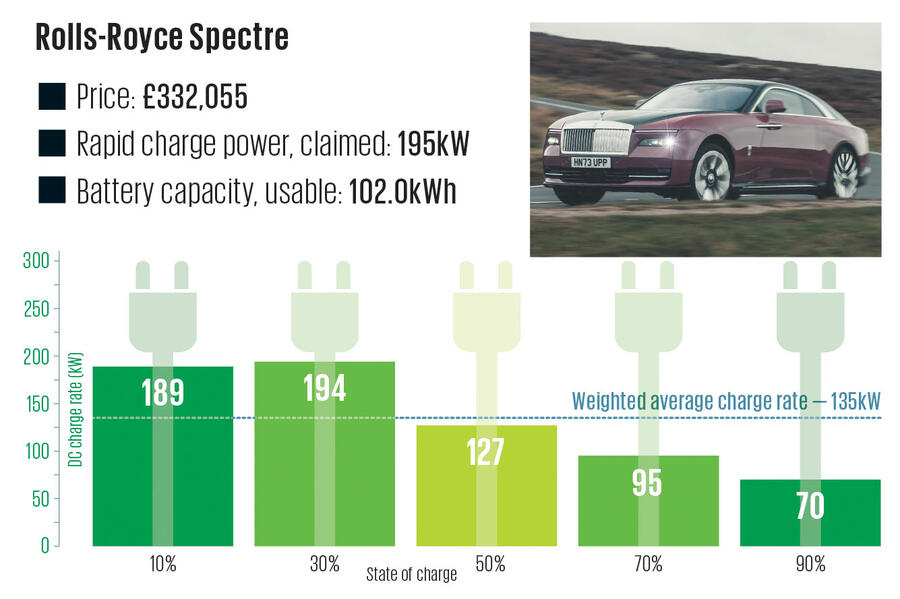
Claimed peak rate: 195kW
Peak rate on test: 194kW
Average test charge rate: 135kW
Usable battery capacity: 102kWh
Test charger: Kempower Satellite Charger, 400kW
Test charge conditions: dry, 11deg C
9. Mercedes EQE 350+ AMG Line Premium (2022)
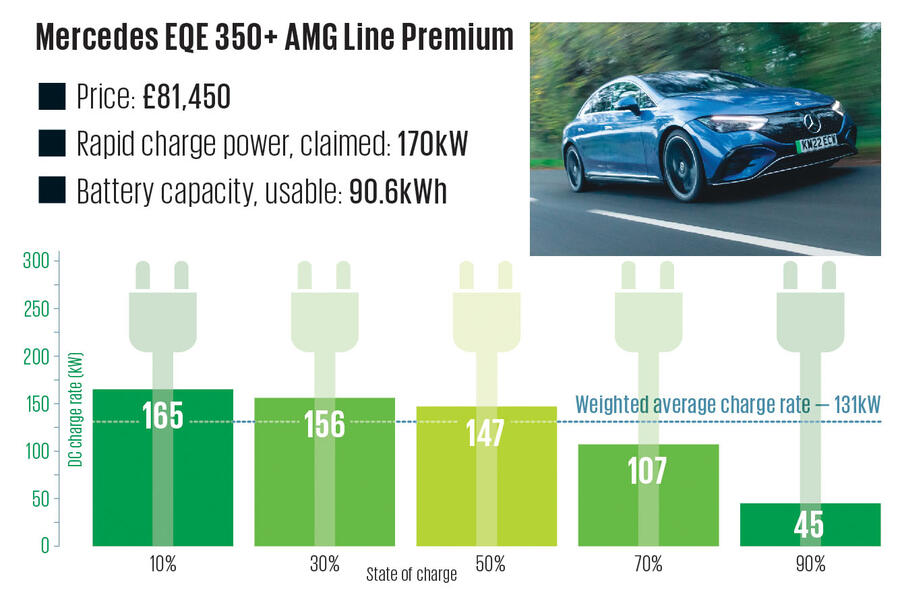
Claimed peak rate: 170kW
Peak rate on test: 165kW
Average test charge rate: 131kW
Usable battery capacity: 90.6kWh
Test charger: Tritium TRI 121-350, operated by Gridserve
Test charge conditions: dry, 13deg C
10. Polestar 2 Long Range Single Motor (2023)
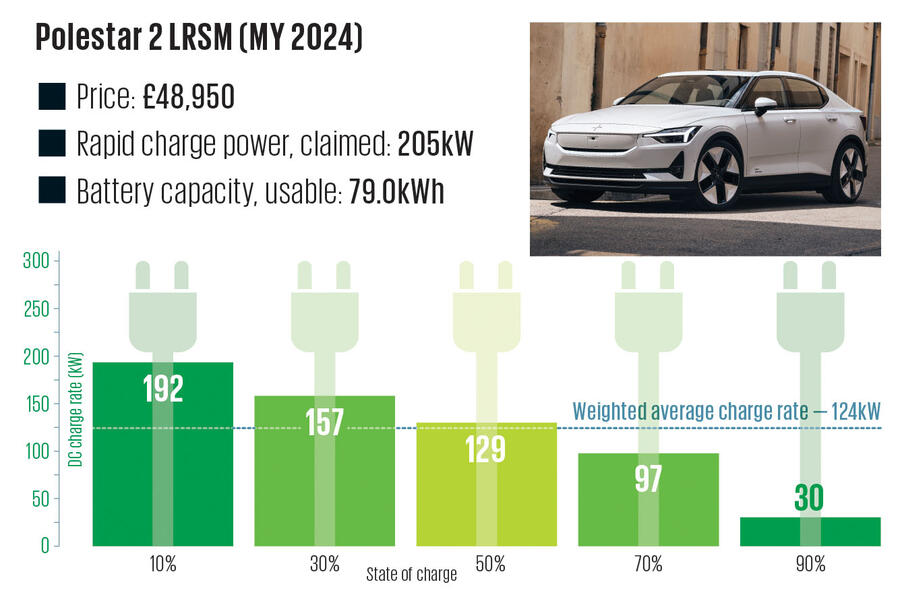
Claimed peak rate: 205kW
Peak rate on test: 192kW
Average test charge rate: 124kW
Usable battery capacity: 79kWh
Test charger: Tritium TRI 121-350, operated by Gridserve
Test charge conditions: dry, 29deg C
11. BMW i5 eDrive40 M Sport
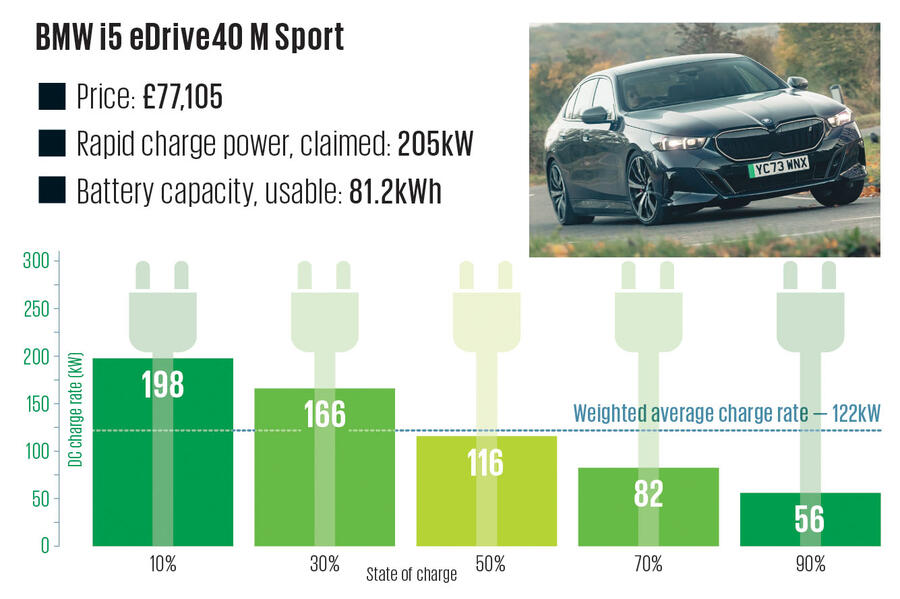
Claimed peak rate: 205kW
Peak rate on test: 198kW
Average test charge rate: 122kW
Usable battery capacity: 81.2kWh
Test charger: Tritium TRI 121-350, operated by Gridserve
Test charge conditions: dry, 12deg C
12. Hyundai Ioniq 5 77kWh RWD Ultimate
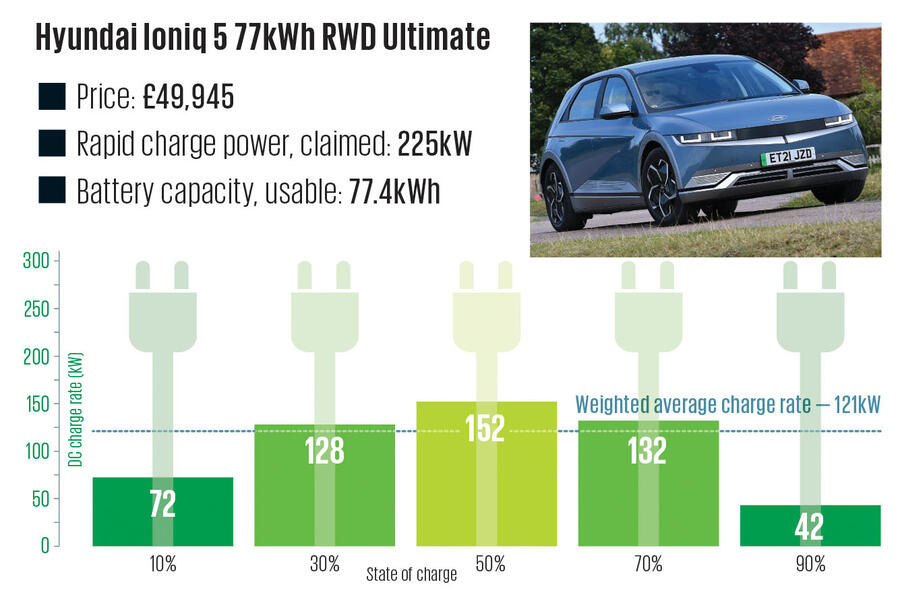
Claimed peak rate: 225kW
Peak rate on test: 152kW
Average test charge rate: 121kW
Usable battery capacity: 77.4kWh
Test charger: Tritium TRI 121-350, operated by Gridserve
Test charge conditions: dry, 1 deg C
13. Tesla Model 3 Long Range (2024)
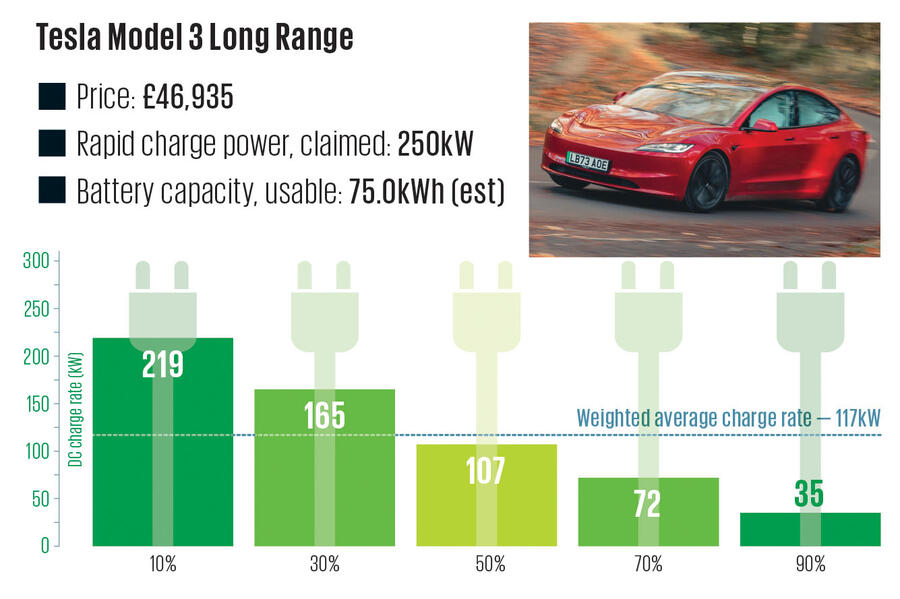
Claimed peak rate: 250kW
Peak rate on test: 219kW
Average test charge rate: 117kW
Usable battery capacity: 75.0kWh (est)
Test charger: Tesla V3 Supercharger
Test charge conditions: dry, 14 deg C
14. Volkswagen ID Buzz SWB Style Pro (2023)
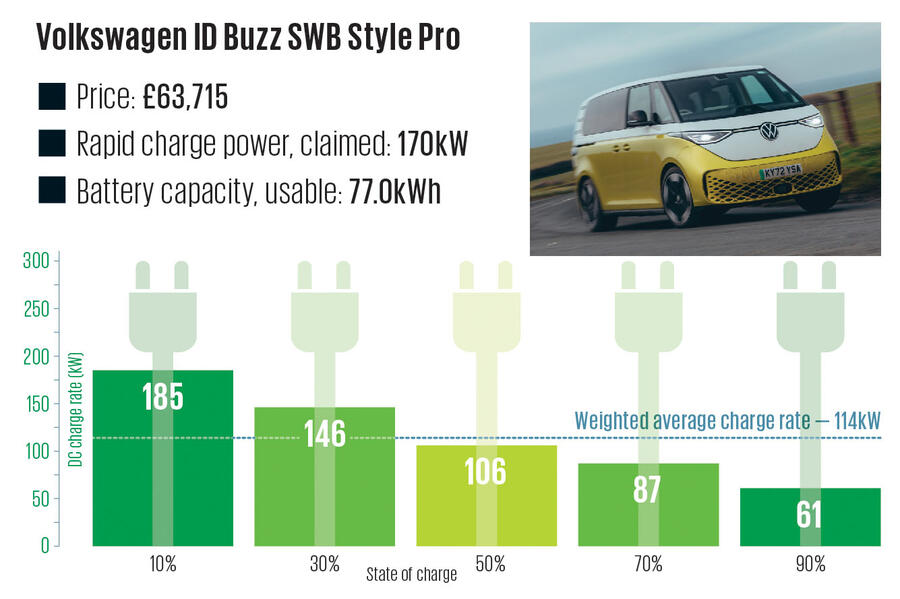
Claimed peak rate: 170kW
Peak rate on test: 185kW
Average test charge rate: 114kW
Usable battery capacity: 77.0kWh
Test charger: Tritium TRI 121-350, operated by Gridserve
Test charge conditions: dry, 9deg C
15. Audi Q8 E-tron 55 Quattro Vorsprung (2024)
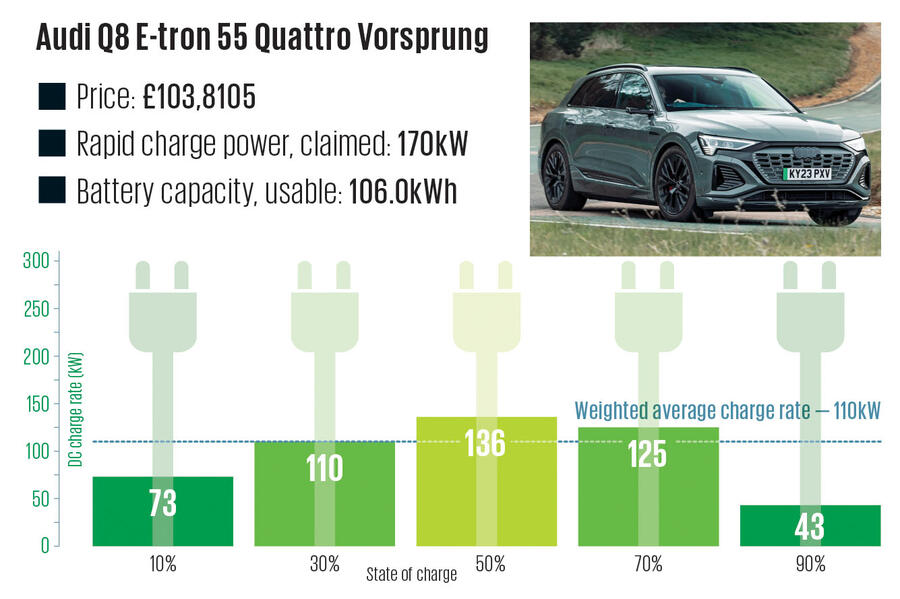
Claimed peak rate: 170kW
Peak rate on test: 136kW
Average test charge rate: 110kW
Usable battery capacity: 106kWh
Test charger: Tritium TRI 121-350, operated by Gridserve
Test charge conditions: dry, 4 deg C
16. MG Motor MG 4 Long Range SE
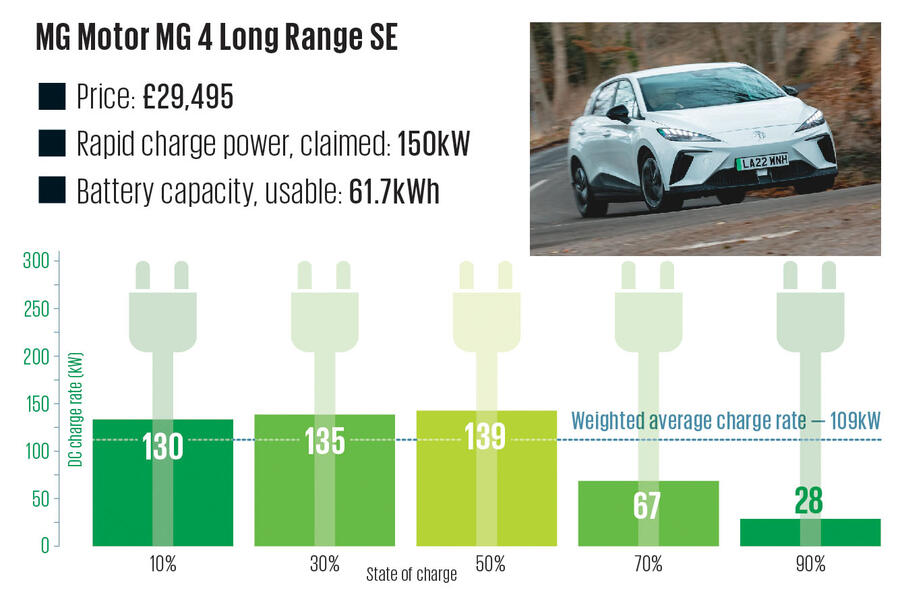
Claimed peak rate: 135kW
Peak rate on test: 139kW
Average test charge rate: 109kW
Usable battery capacity: 61.7kWh
Test charger: ABB HP CP500 CJ, operated by Gridserve
Test charge conditions: rain, 4 deg C
17. Volvo C40 Recharge Plus Single Motor (2023)
Claimed peak rate: 150kW
Peak rate on test: 134kW
Average test charge rate: 104kW
Usable battery capacity: 67.0kWh
Test charger: Tritium TRI 121-350, operated by Gridserve
Test charge conditions: dry, 14deg C
18. BYD Seal Design RWD
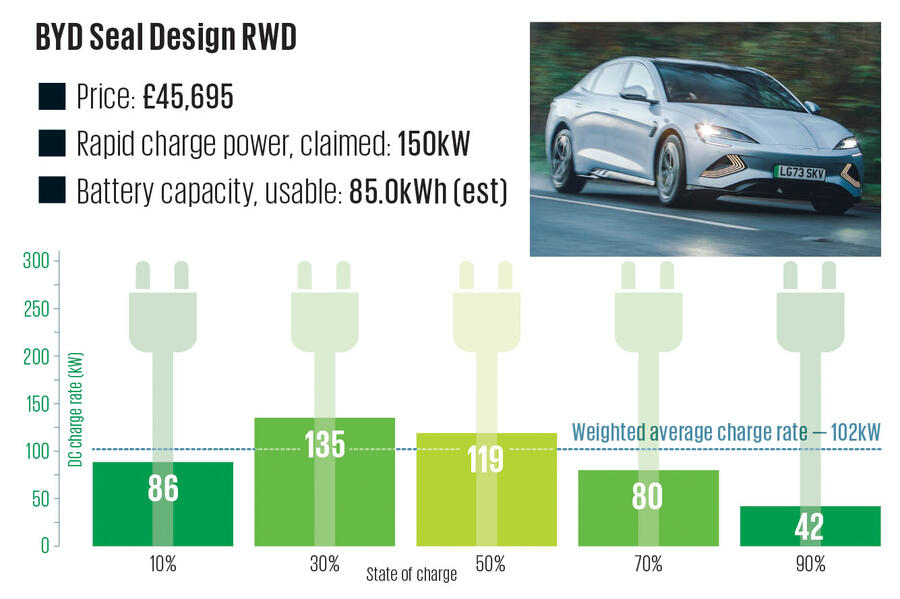
Claimed peak rate: 150kW
Peak rate on test: 135kW
Average test charge rate: 102kW
Usable battery capacity: 85kWh (est)
Test charger: Fastned/Gridserve, 350kW
Test charge conditions: dry, 3 deg C
19. Smart #1 Premium
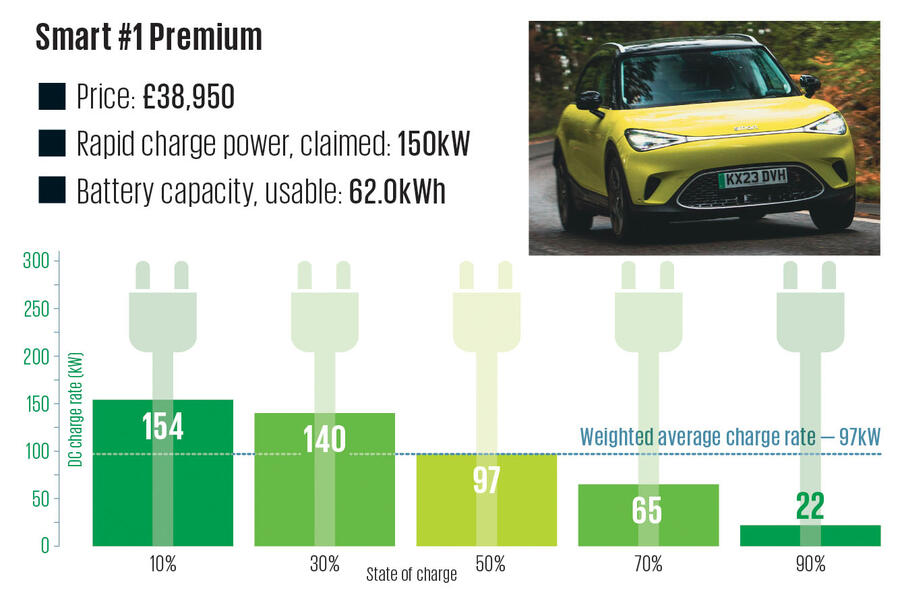
Claimed peak rate: 150kW
Peak rate on test: 154kW
Average test charge rate: 97kW
Usable battery capacity: 62kWh
Test charger: Fastned, 350kW
Test charge conditions: dry, 12 deg C
20. Polestar 2 BST Edition 270 (2023)
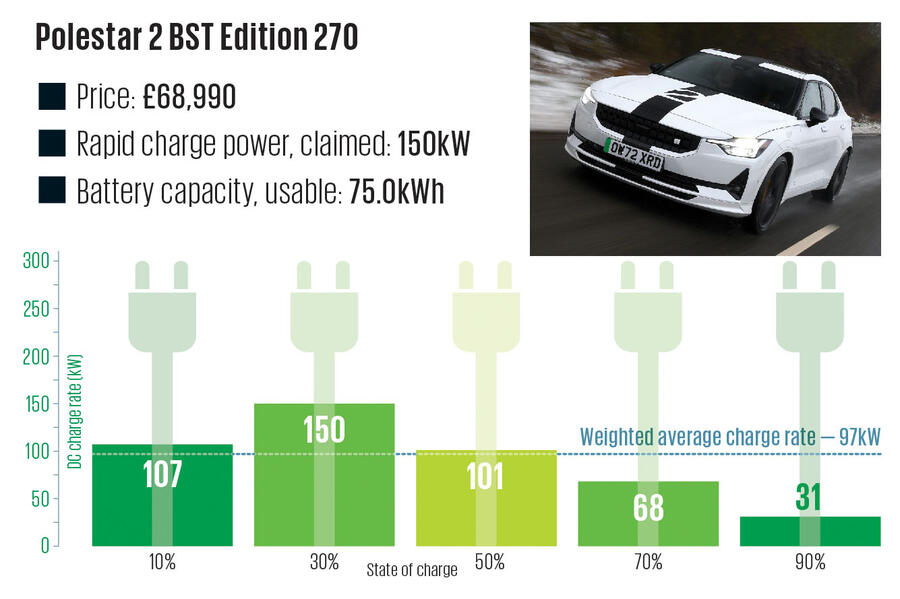
Claimed peak rate: 150kW
Peak rate on test: 150kW
Average test charge rate: 97kW
Usable battery capacity: 75.0kWh
Test charger: Alpitronic HYC 150, operated by Instavolt
Test charge conditions: light rain, 12 deg C
21. BMW iX1 xDrive30 xLine (2023)
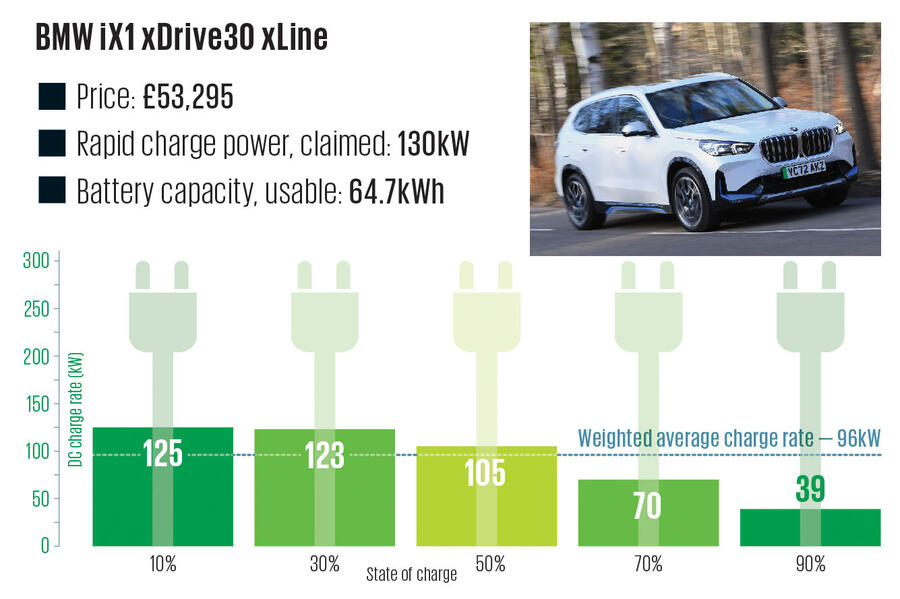
Claimed peak rate: 130kW
Peak rate on test: 125kW
Average test charge rate: 96kW
Usable battery capacity: 64.7kWh
Test charger: Hypercharger HYC_150, operated by MFG EV Power
Test charge conditions: dry, 7 deg C
22. Toyota BZ4X AWD Motion (2022)
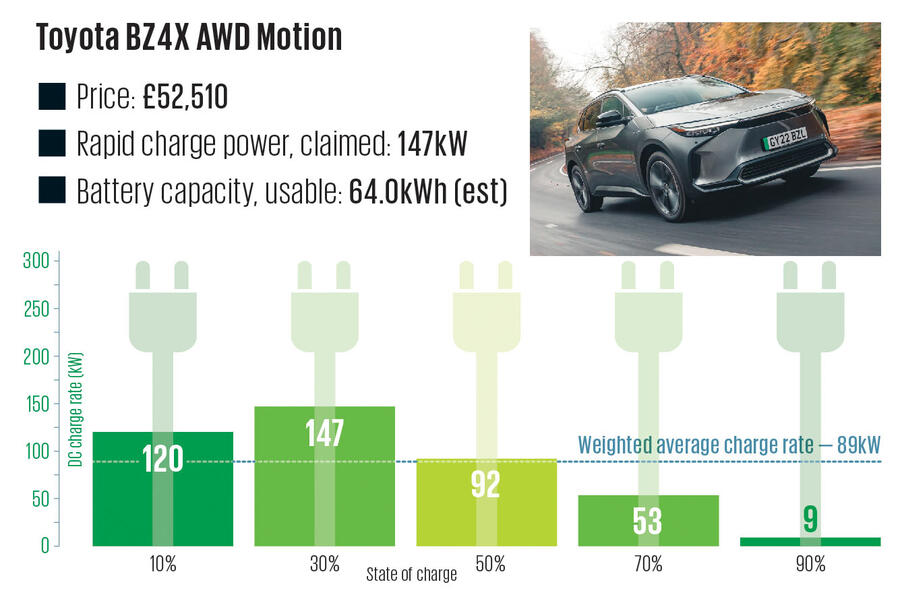
Claimed peak rate: 150kW
Peak rate on test: 147kW
Average test charge rate: 89kW
Usable battery capacity: 64.0kWh
Test charger: ABB HP CP500C, operated by Ionity
Test charge conditions: not recorded
23. Tesla Model Y RWD (2023)
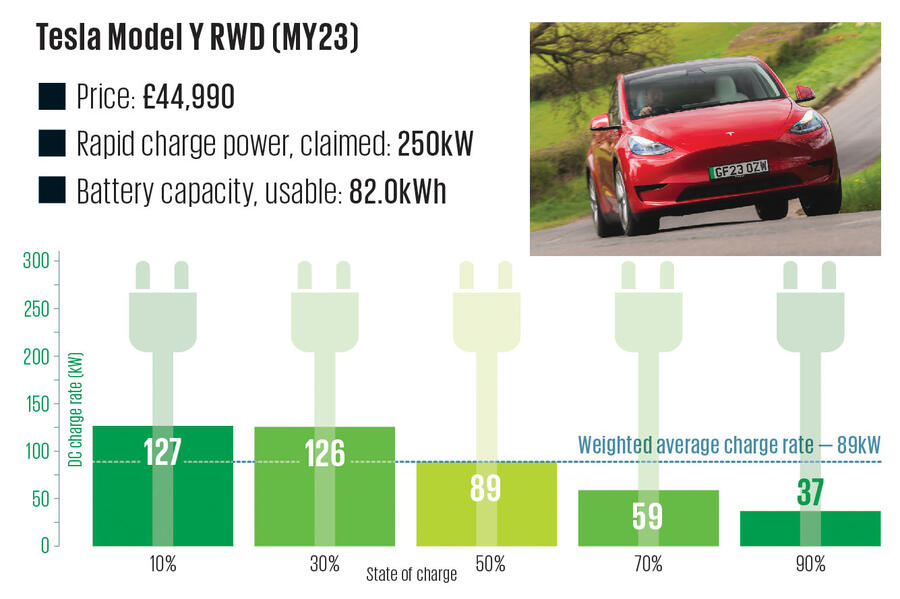
Claimed peak rate: 250kW
Peak rate on test: 127kW
Average test charge rate: 89kW
Usable battery capacity: 82.0kWh (est)
Test charger: V2 Supercharger, operated by Tesla
Test charge conditions: dry, 16deg C
24. Lexus RZ 450e (2023)
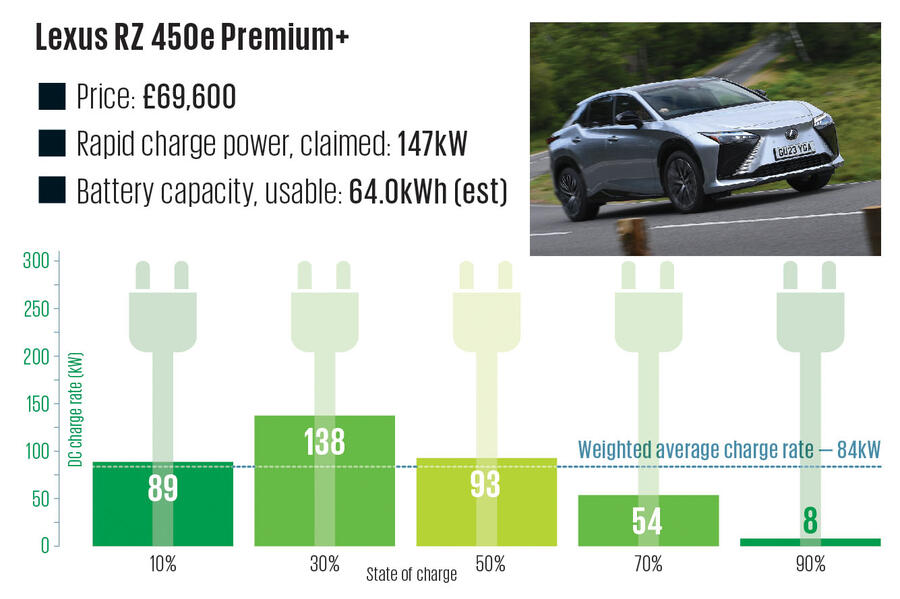
Claimed peak rate: 150kW
Peak rate on test: 138kW
Average test charge rate: 84kW
Usable battery capacity: 64.0kWh (est)
Test charger: ABB HP CP500C, operated by Ionity
Test charge conditions: dry, 12 deg C
25. Subaru Solterra AWD Touring (2023)
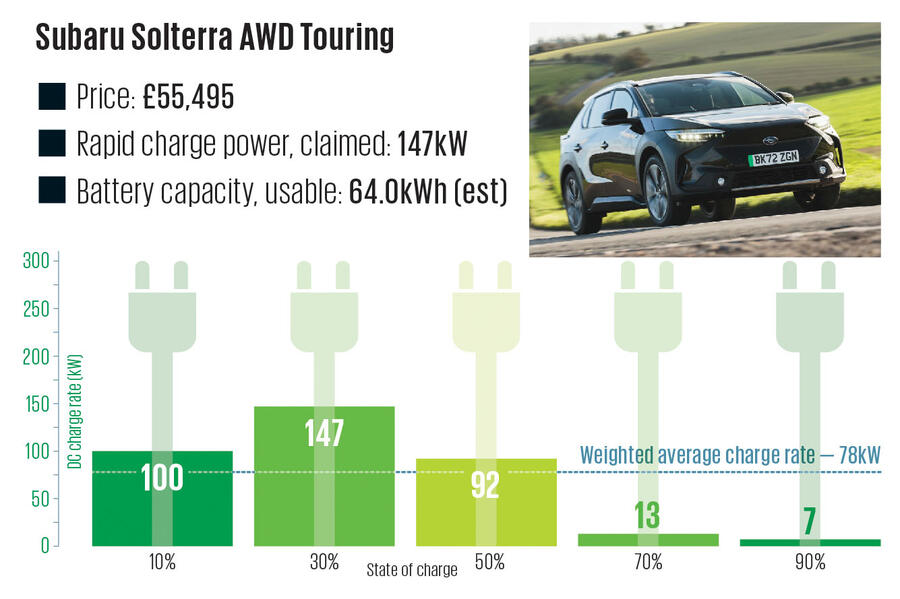
Claimed peak rate: 150kW
Peak rate on test: 147kW
Average test charge rate: 78kW
Usable battery capacity: 64.0kWh
Test charger: Tritium TRI 121-350, operated by Gridserve
Test charge conditions: dry, 6 deg C
26. Renault Megane E-Tech EV60 Techno
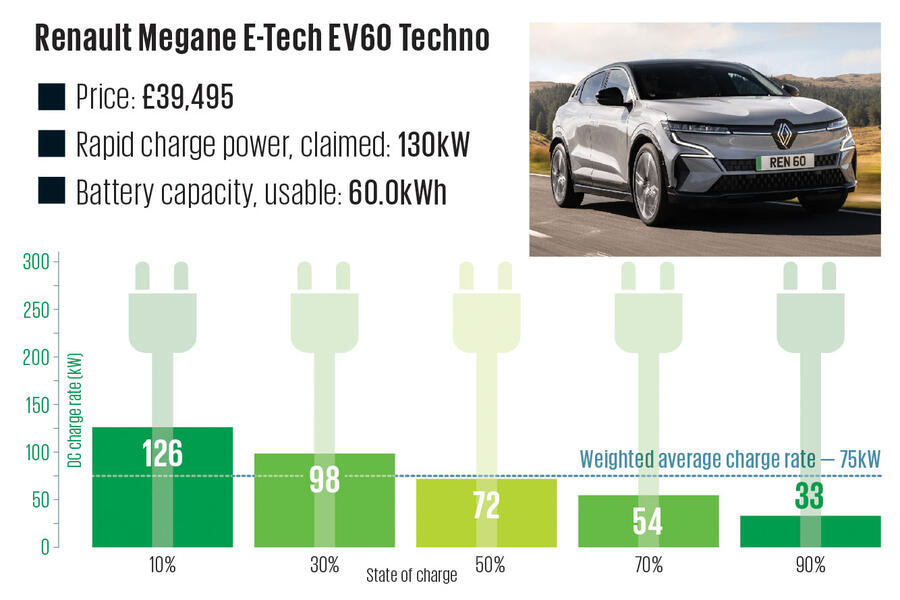
Claimed peak rate: 130kW
Peak rate on test: 126kW
Average test charge rate: 75kW
Usable battery capacity: 60kWh
Test charger: Tritium TRI 121-350, operated by Gridserve
Test charge conditions: dry, 20 deg C
27. Jeep Avenger Electric Summit
Claimed peak rate: 100kW
Peak rate on test: 103kW
Average test charge rate: 67kW
Usable battery capacity: 50.8kWh
Test charger: ABB Terra 360, operated by Gridserve
Test charge conditions: wet, 8 deg C
28. BYD Atto 3 (2023)
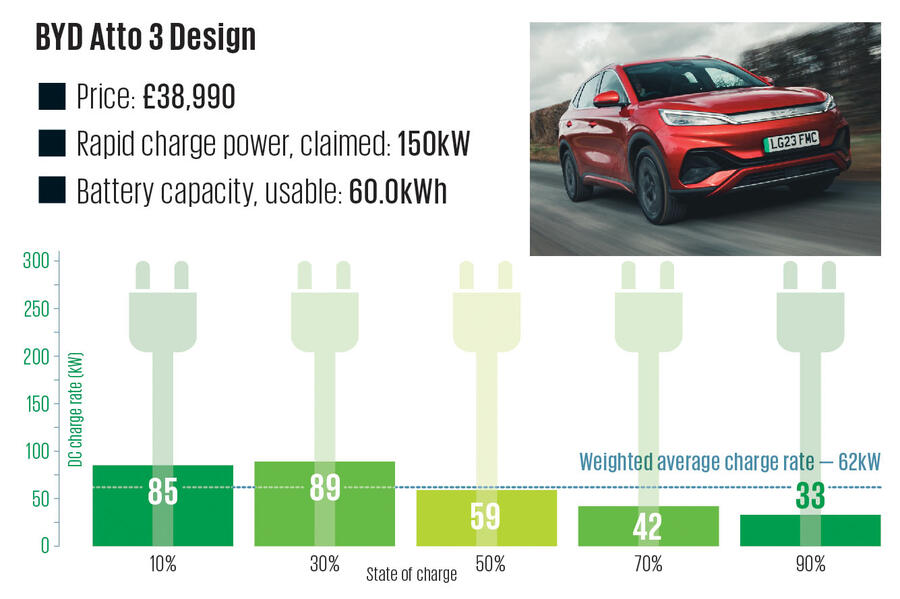
Claimed peak rate: 88kW
Peak rate on test: 89kW
Average test charge rate: 62kW
Usable battery capacity: 60.0kWh (est)
Test charger: ABB HP CP500 CJ, operated by Gridserve
Test charge conditions: dry, 12 deg C
29. Abarth 500e Turismo
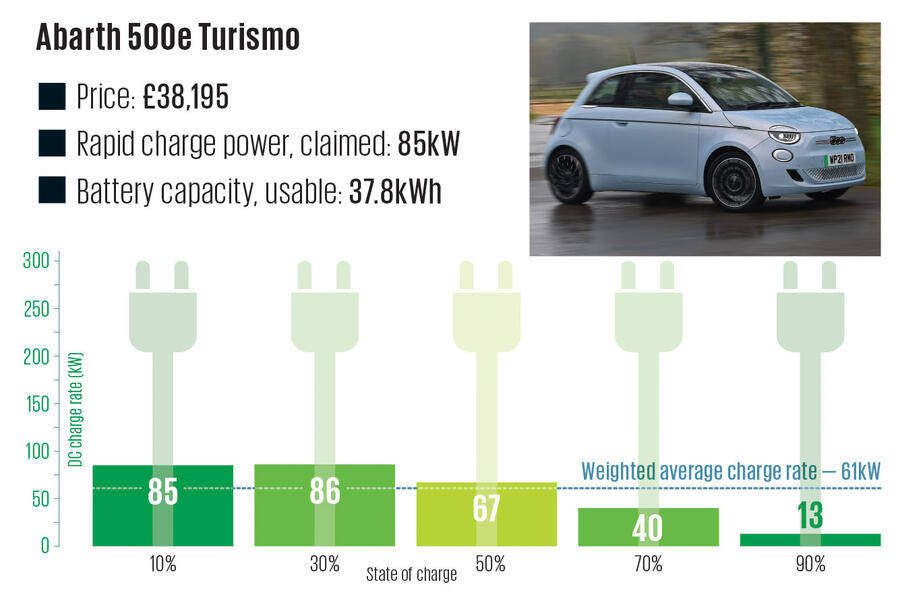
Claimed peak rate: 85kW
Peak rate on test: 86kW
Average test charge rate: 61kW
Usable battery capacity: 37.3kWh
Test charger: Circontrol EV-Raption 150 CCS, operated by MFG EV Power
Test charge conditions: dry, 17 deg C
30. Honda e:Ny1 Advance
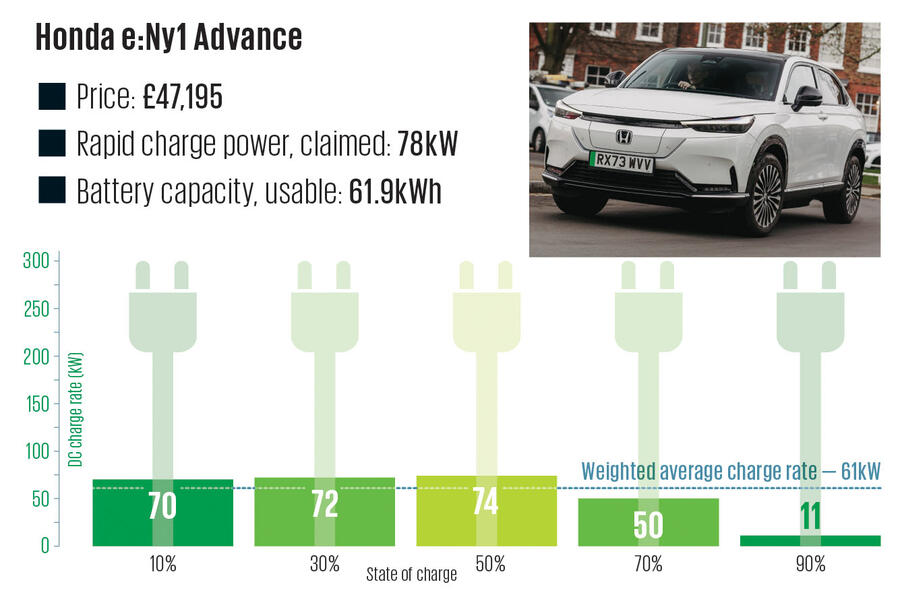
Claimed peak rate: 78kW
Peak rate on test: 74kW
Average test charge rate: 61kW
Usable battery capacity: 61.9kWh
Test charger: Tritium TRI121-350, operated by Gridserve
Test charge conditions: dry, 16 deg C
31. Citroën e-C4 X Shine (2023)
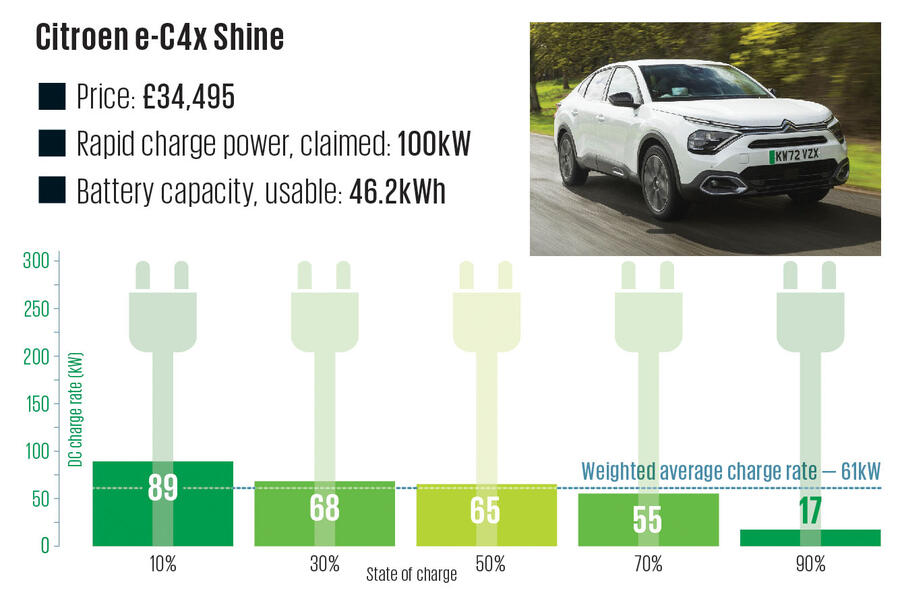
Claimed peak rate: 100kW
Peak rate on test: 89kW
Average test charge rate: 61kW
Usable battery capacity: 46.2kWh
Test charger: Tritium TRI121-350, operated by Gridserve
Test charge conditions: dry, 11 deg C
32. GWM Ora 03 (2023)
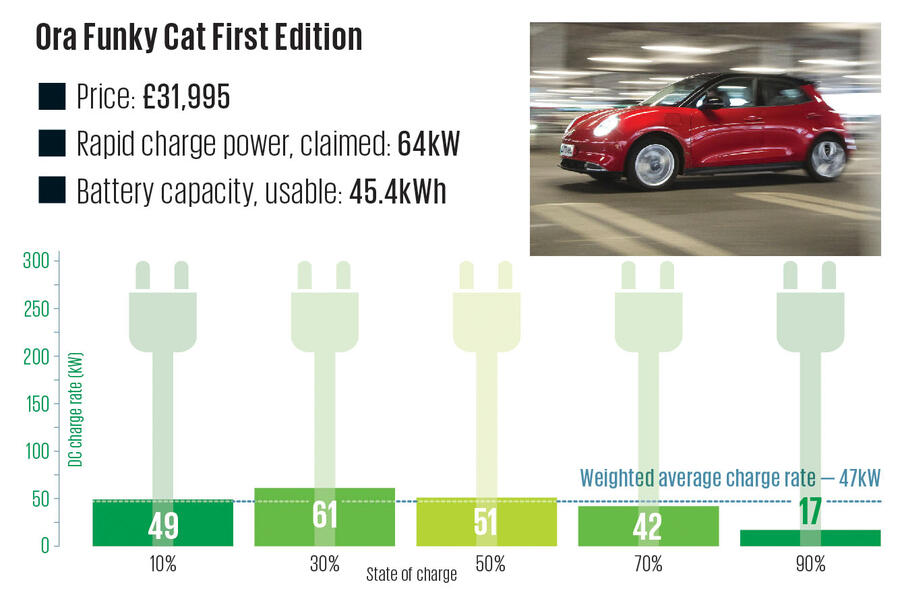
Claimed peak rate: 64kW
Peak rate on test: 61kW
Average test charge rate: 47kW
Usable battery capacity: 45.4kWh
Test charger: ABB HP CP500 CJ, operated by Gridserve
Test charge conditions: unrecorded
33. Kia Soul Urban (2023)
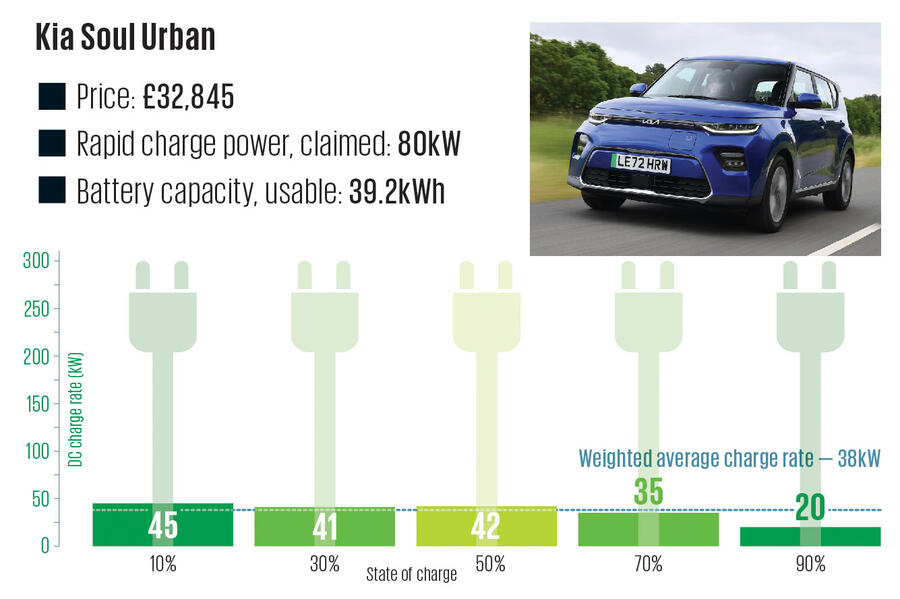
Claimed peak rate: 44kW
Peak rate on test: 45kW
Average test charge rate: 38kW
Usable battery capacity: 39.2kWh
Test charger: ABB HP CP500 CJ, operated by Gridserve
Test charge conditions: not recorded

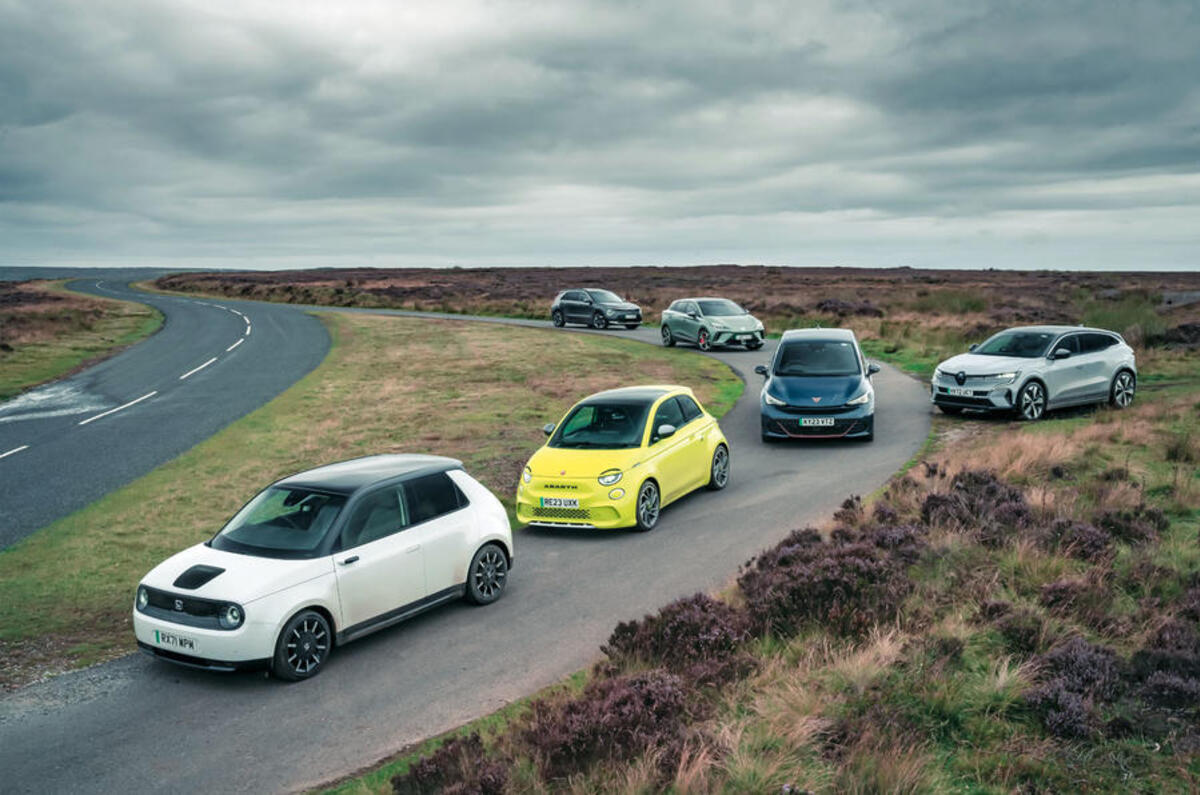
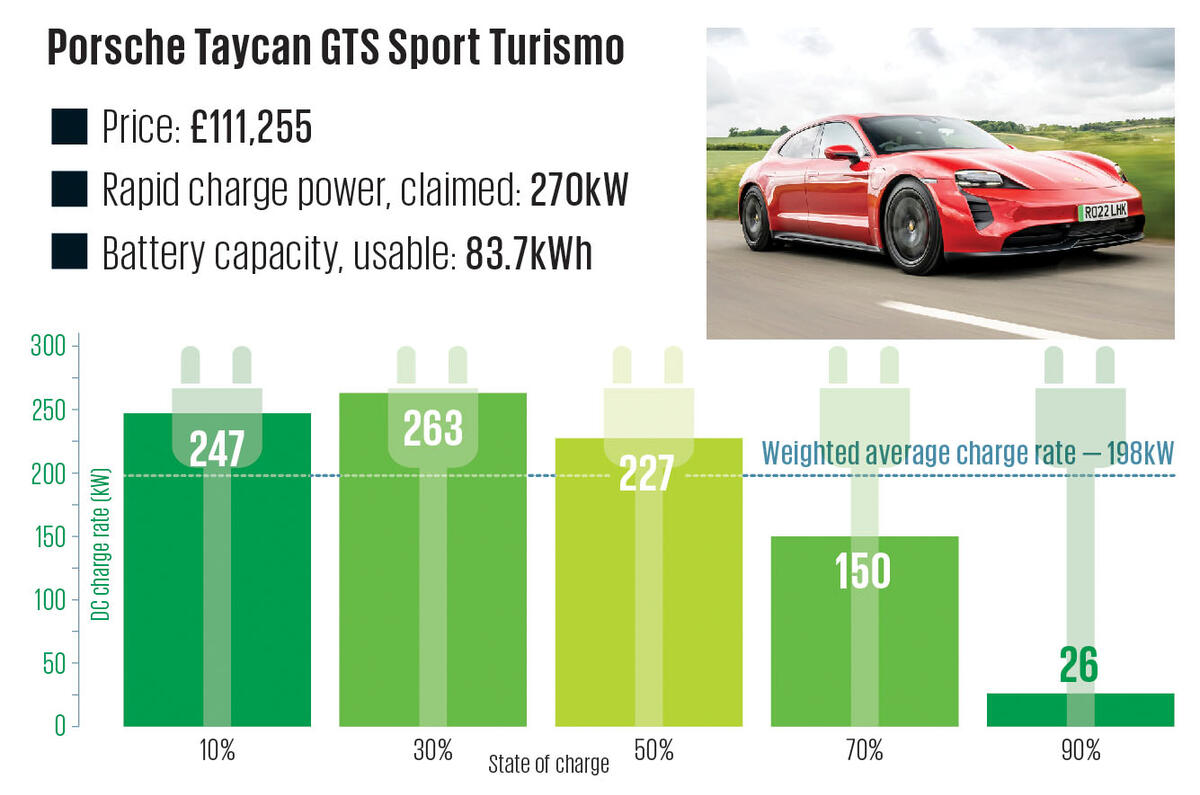
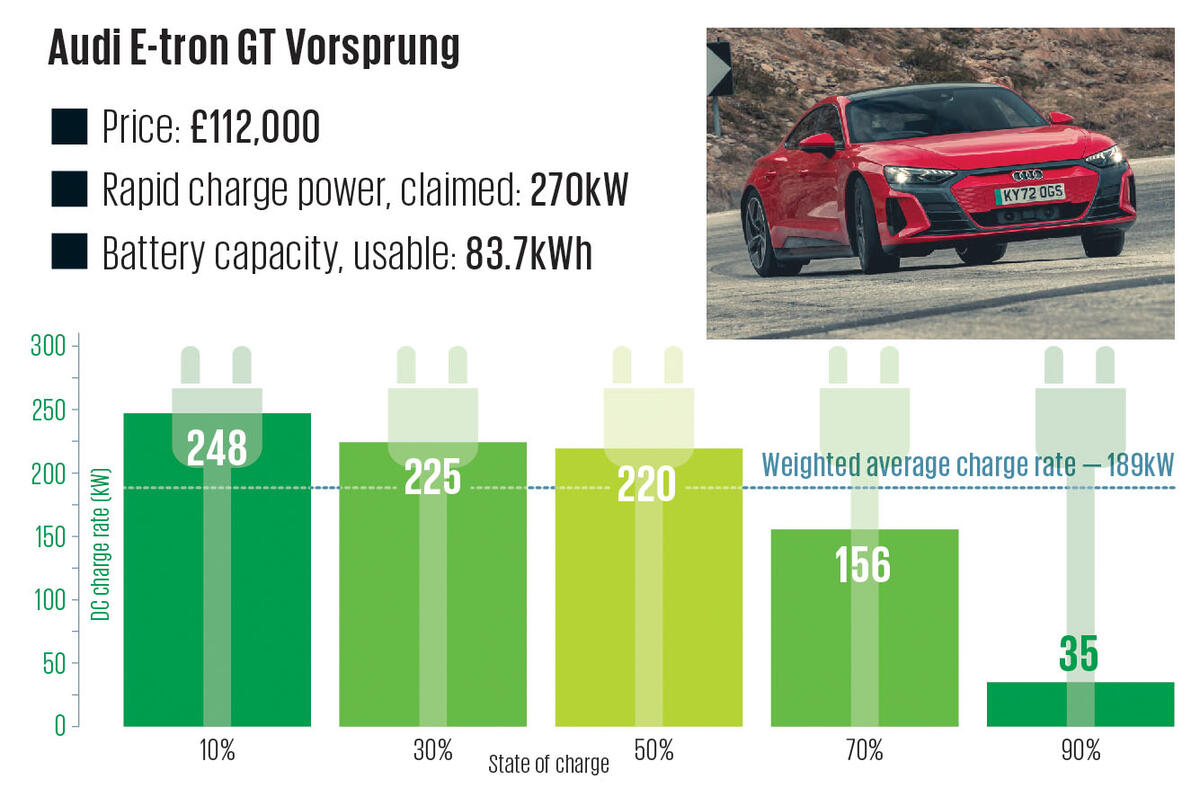
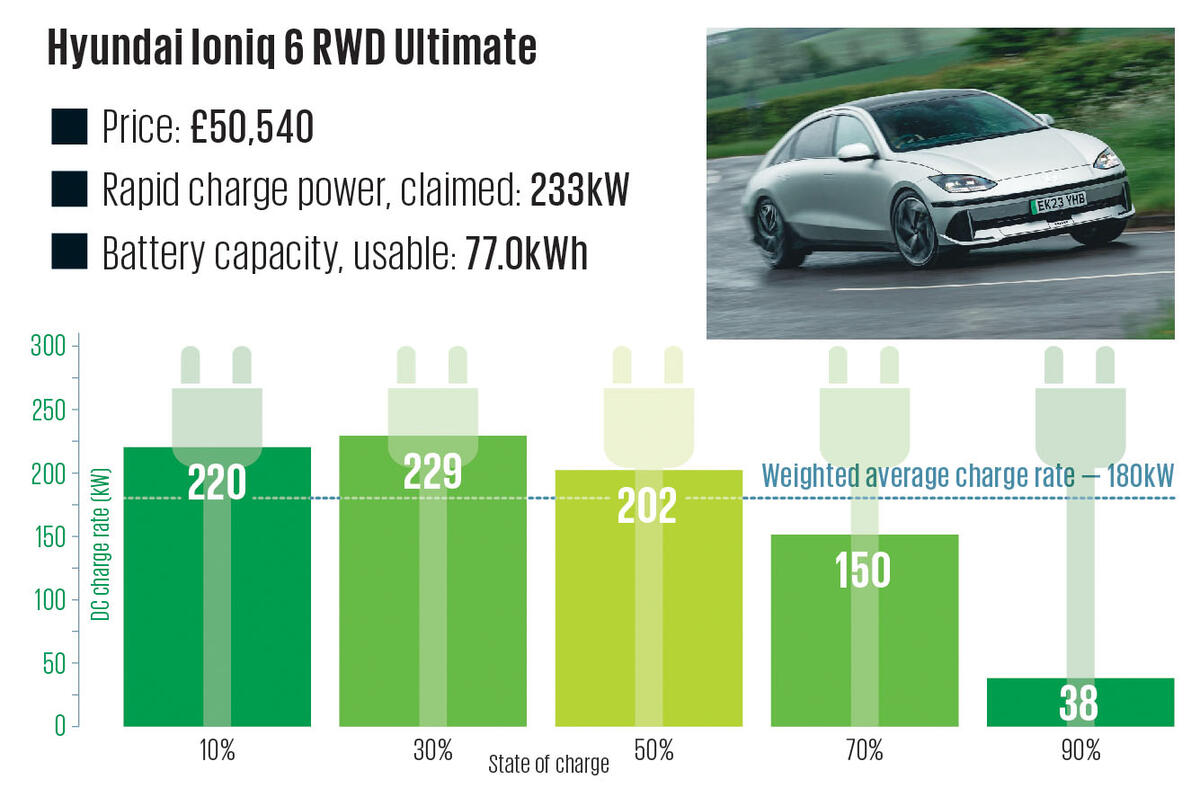
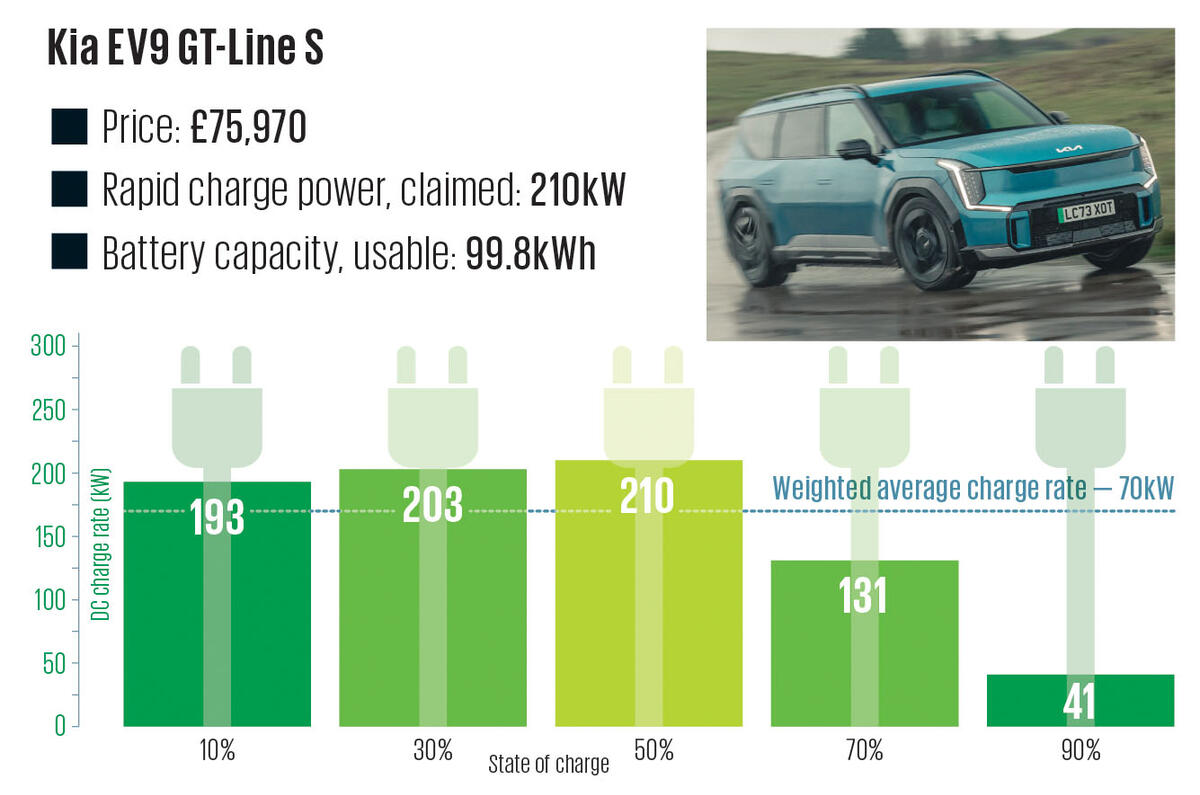
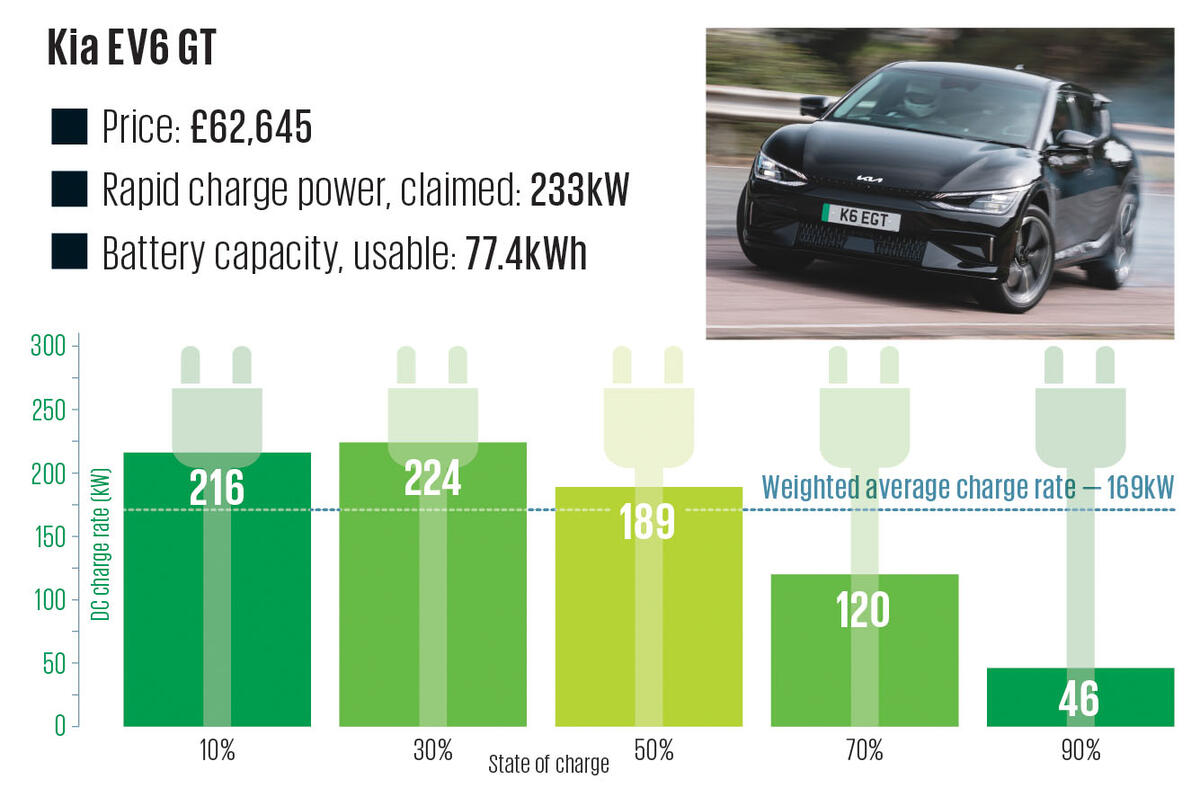
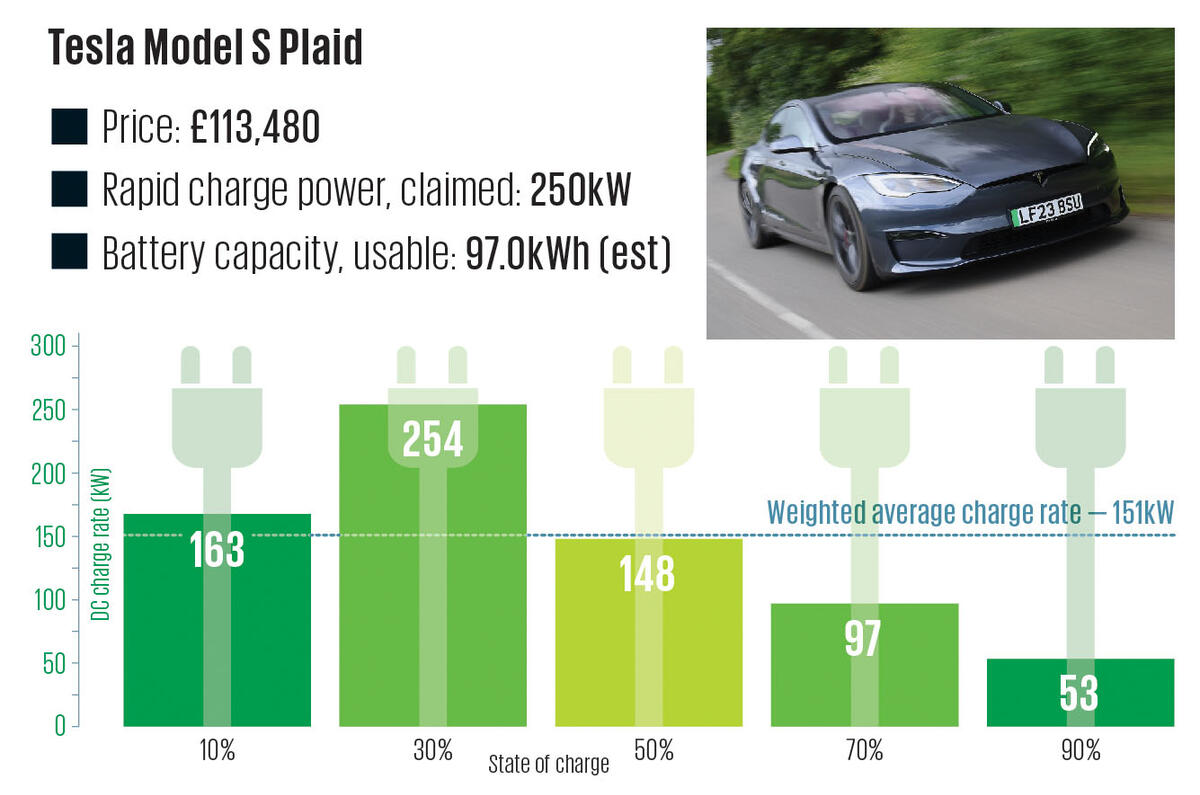
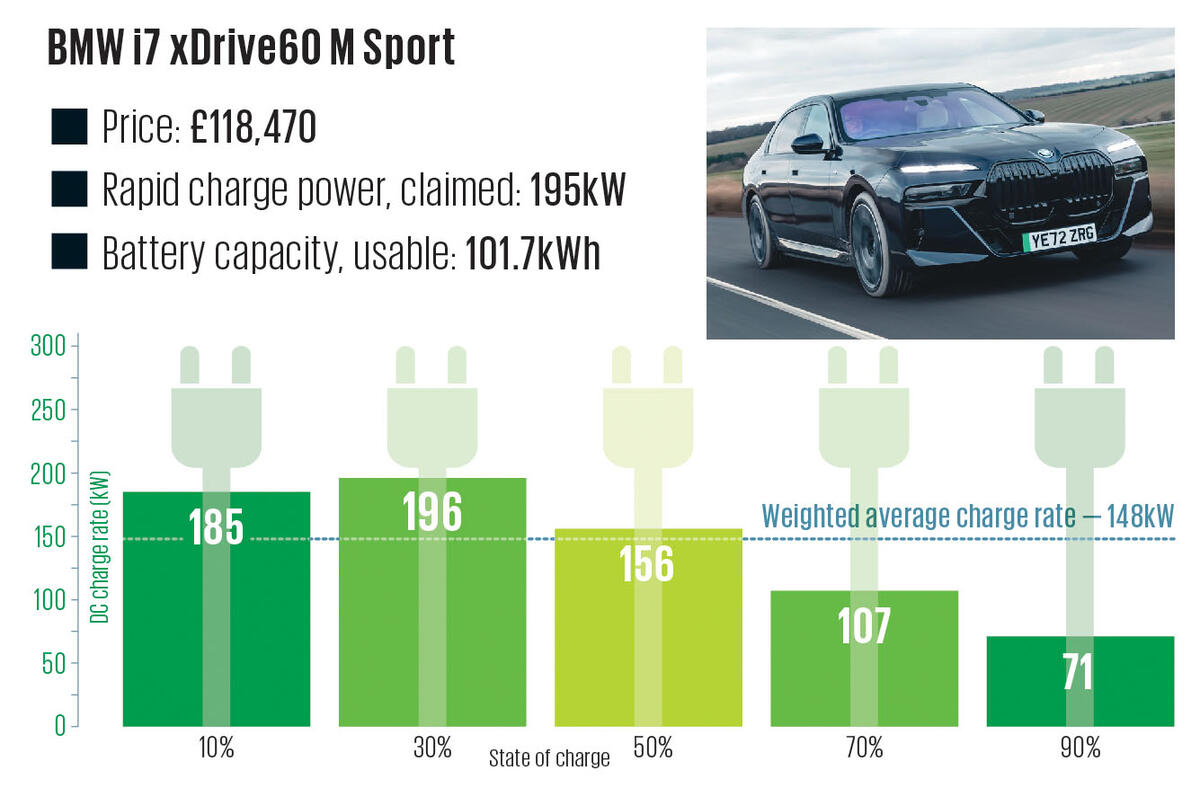
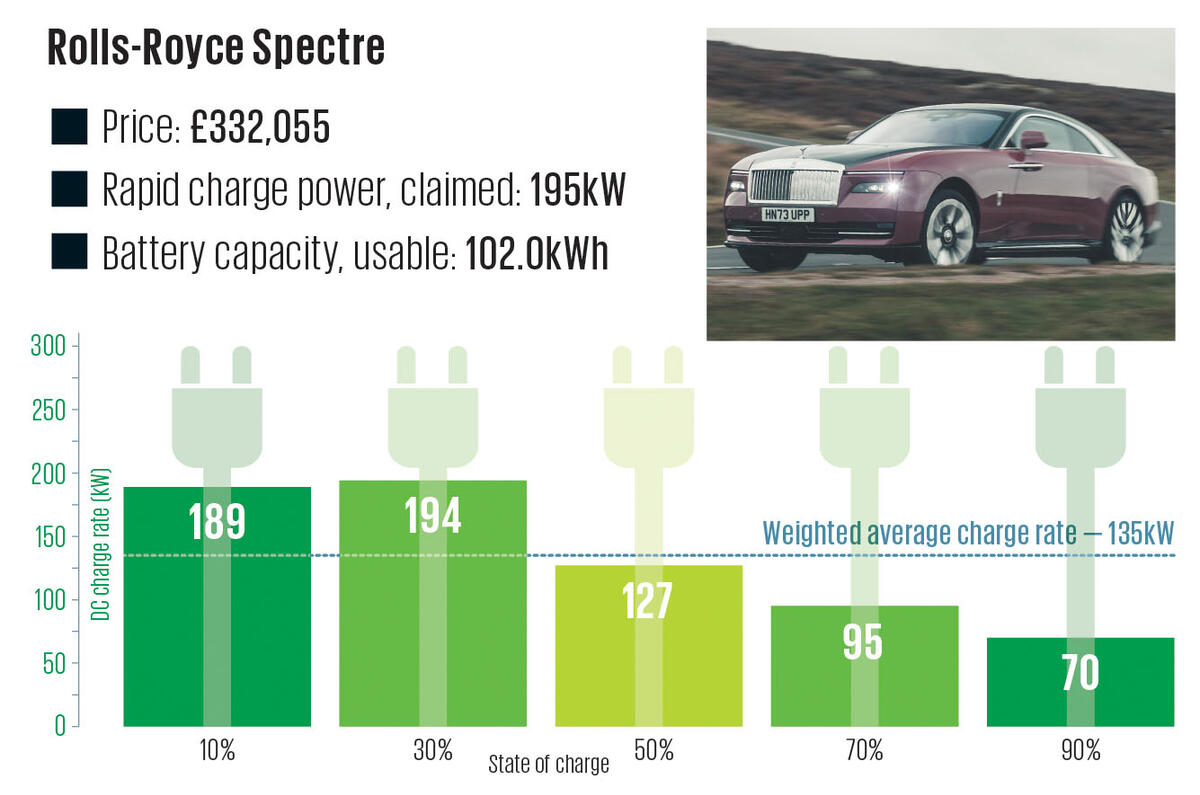
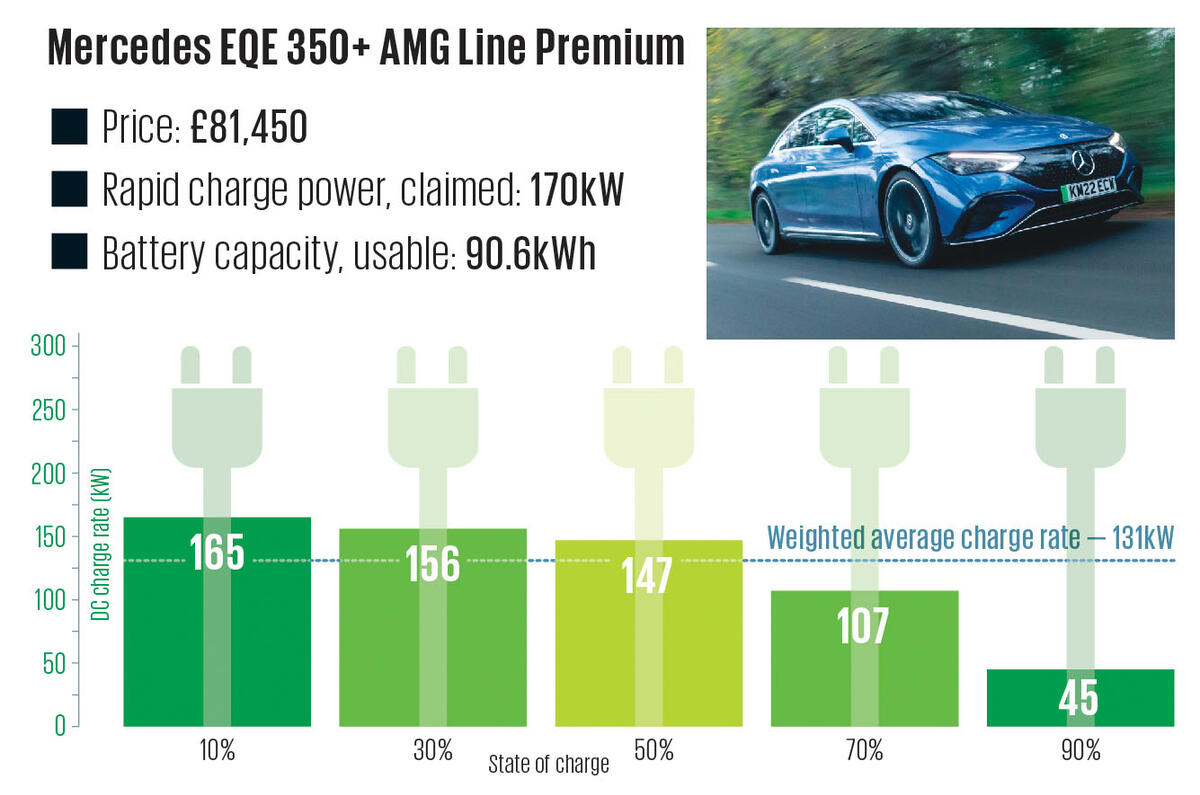
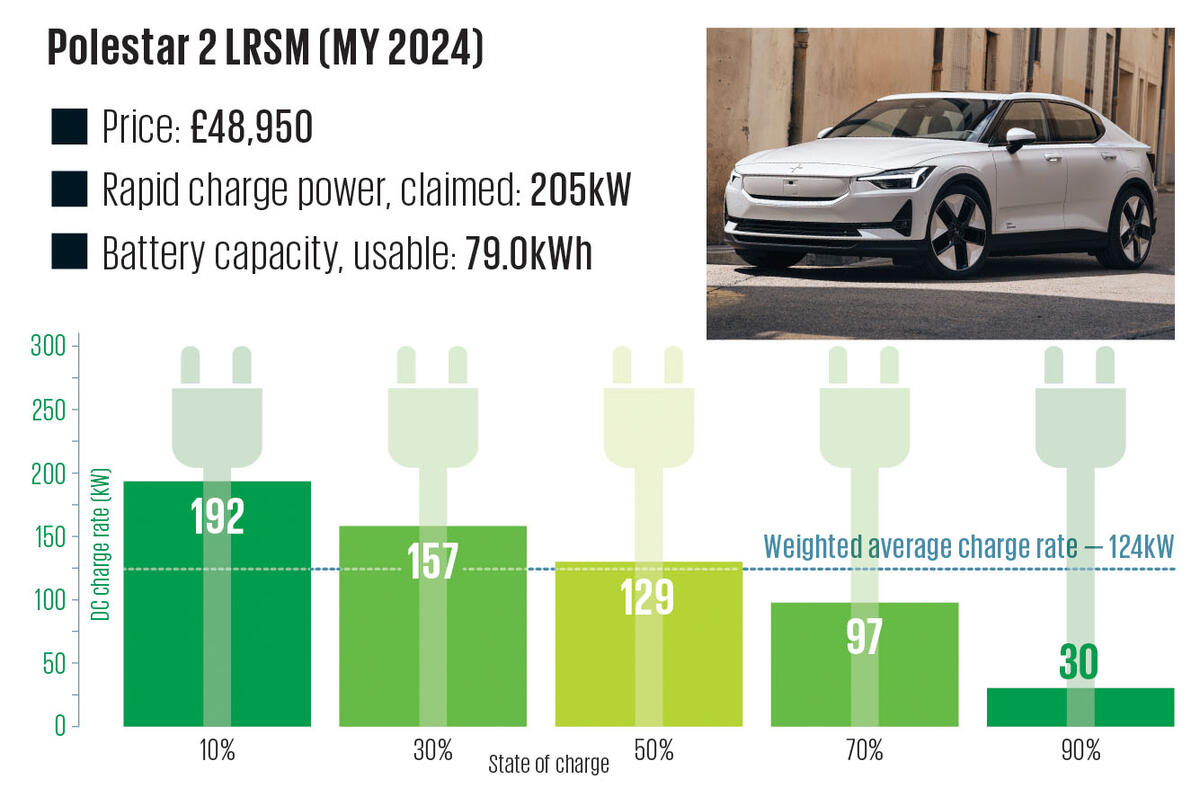
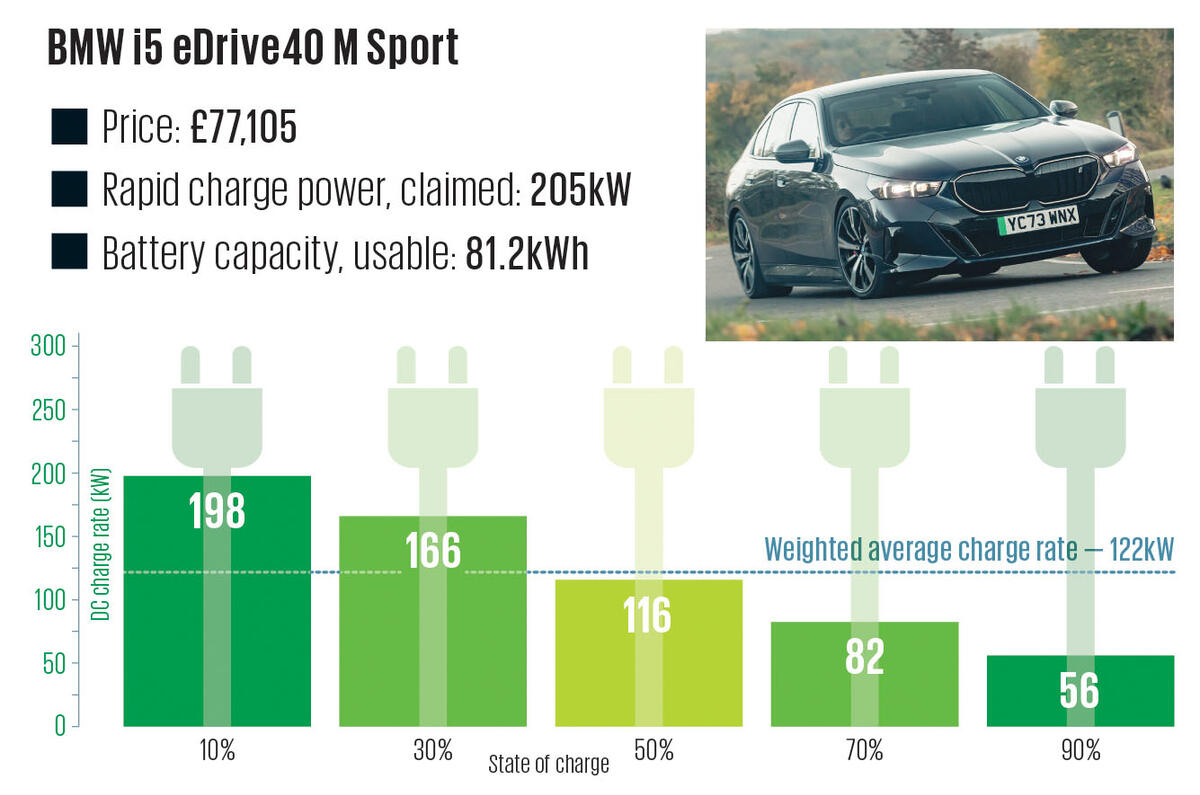
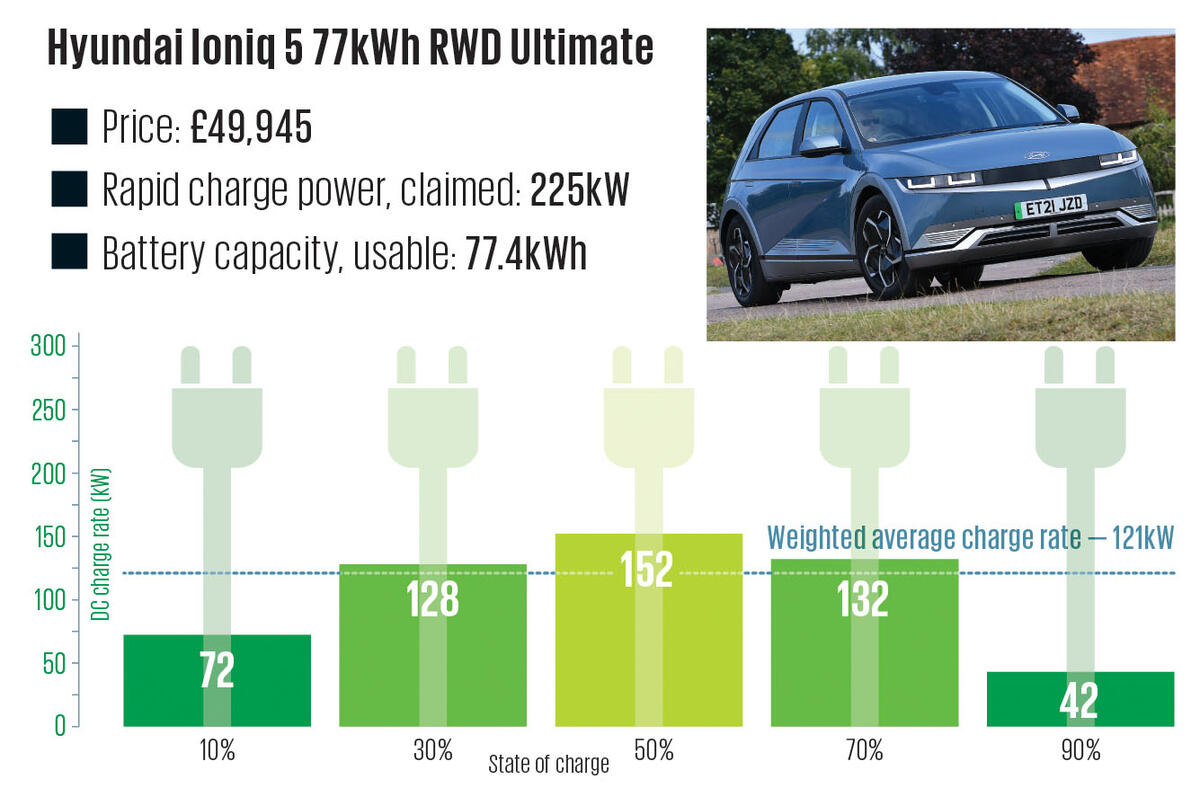
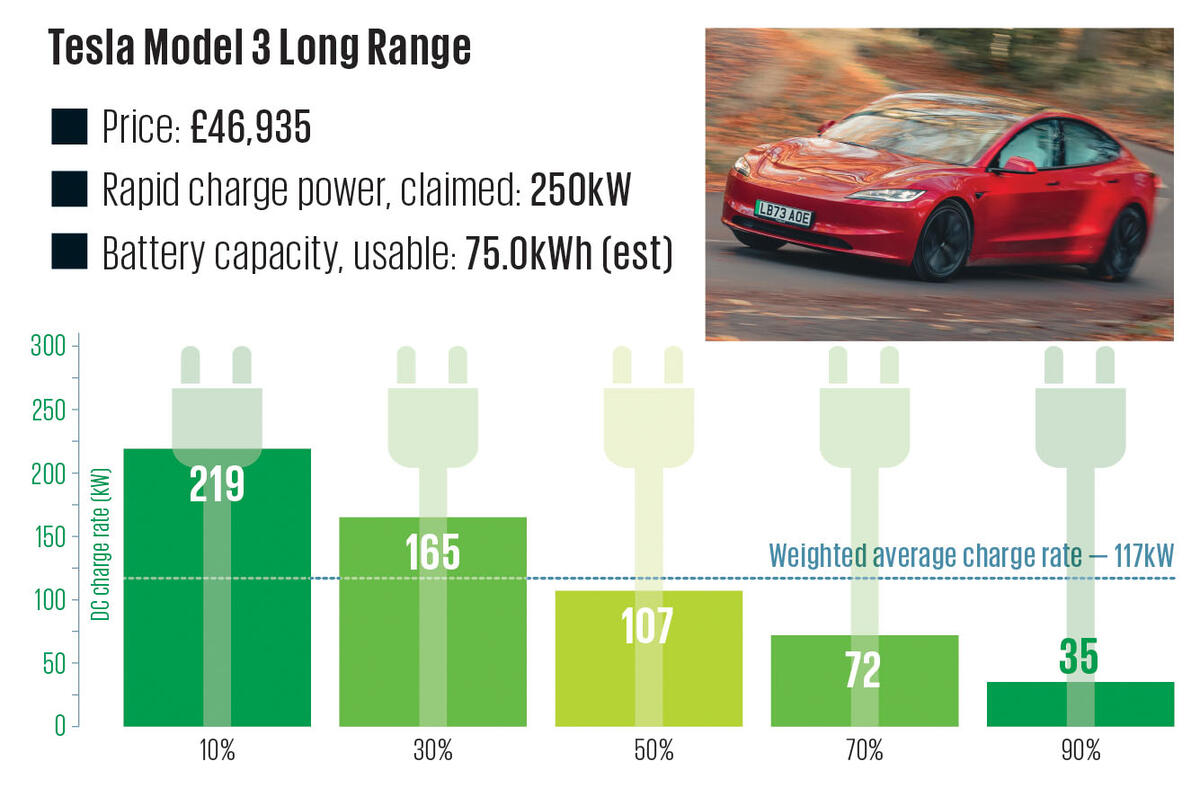
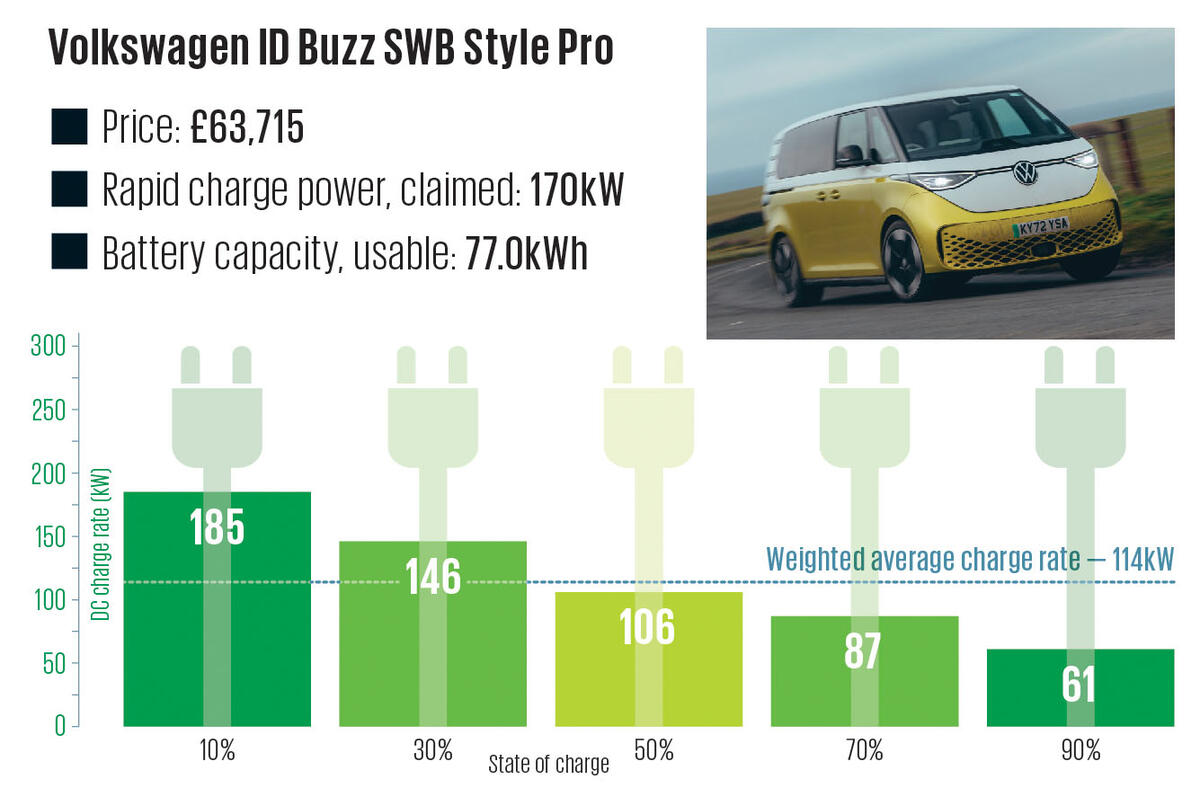
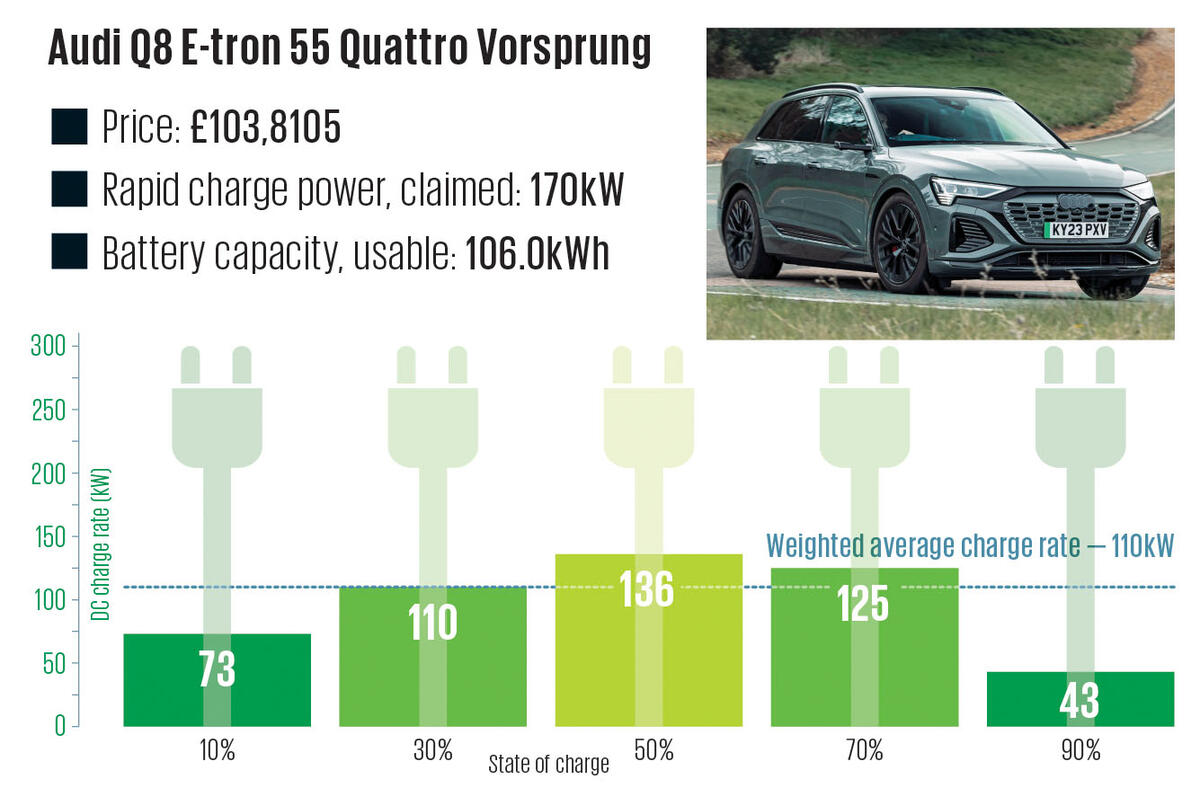

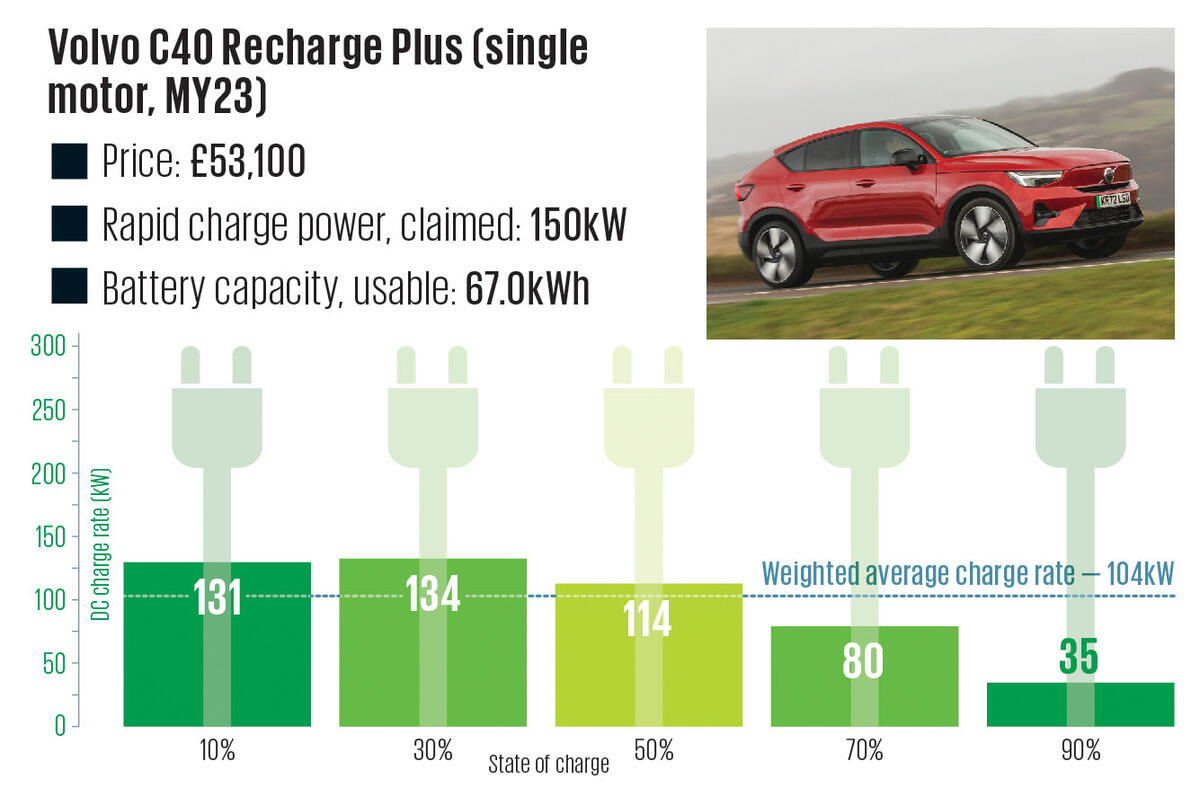
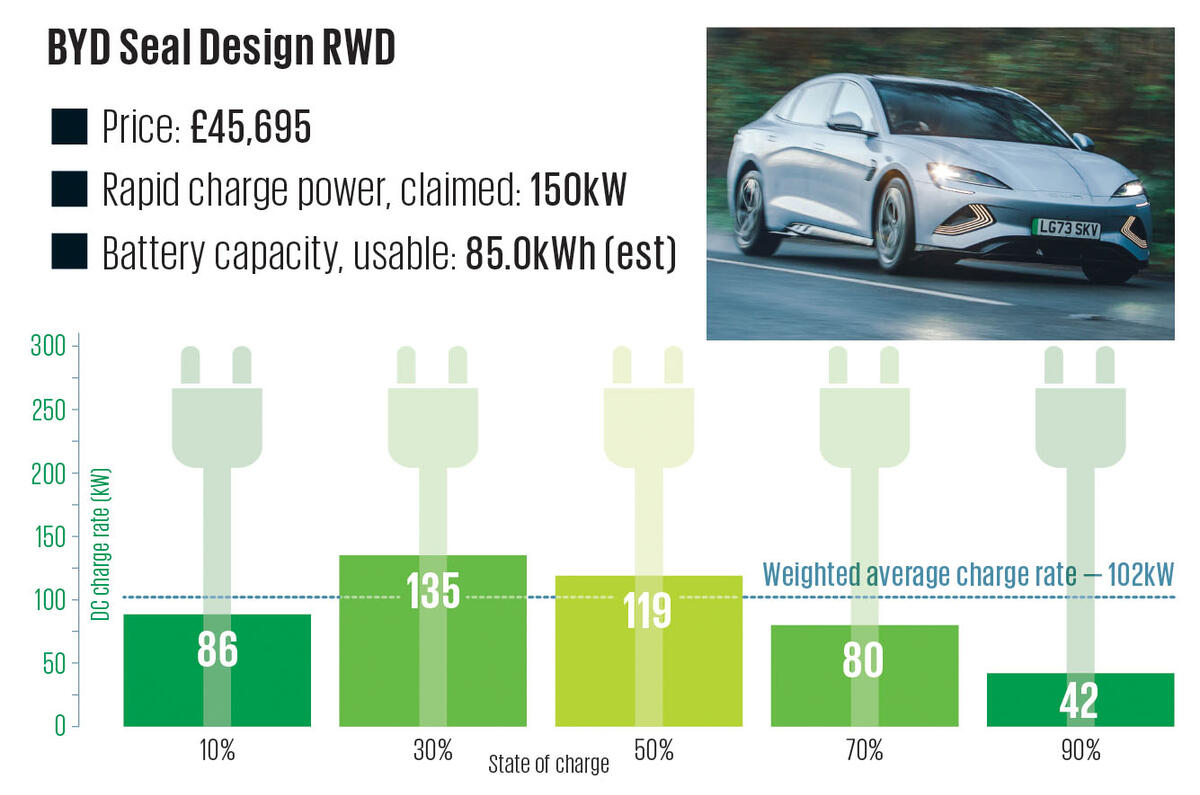
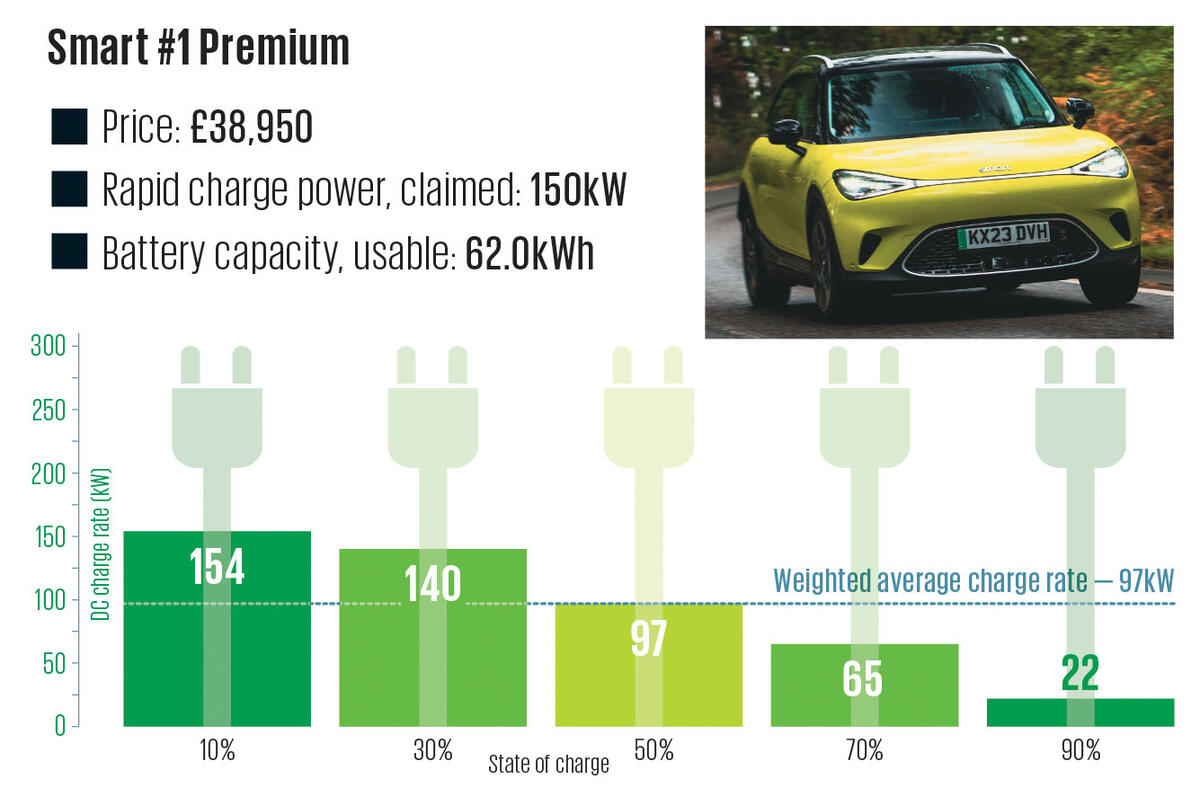
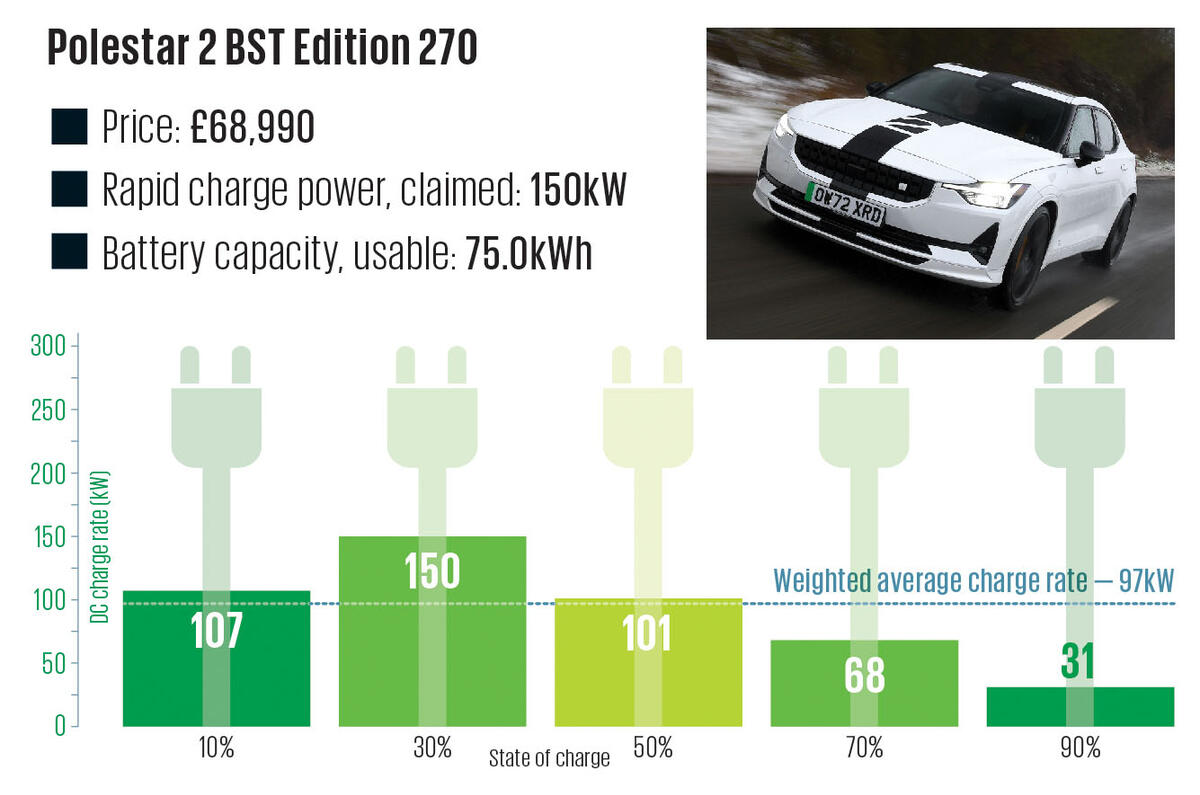
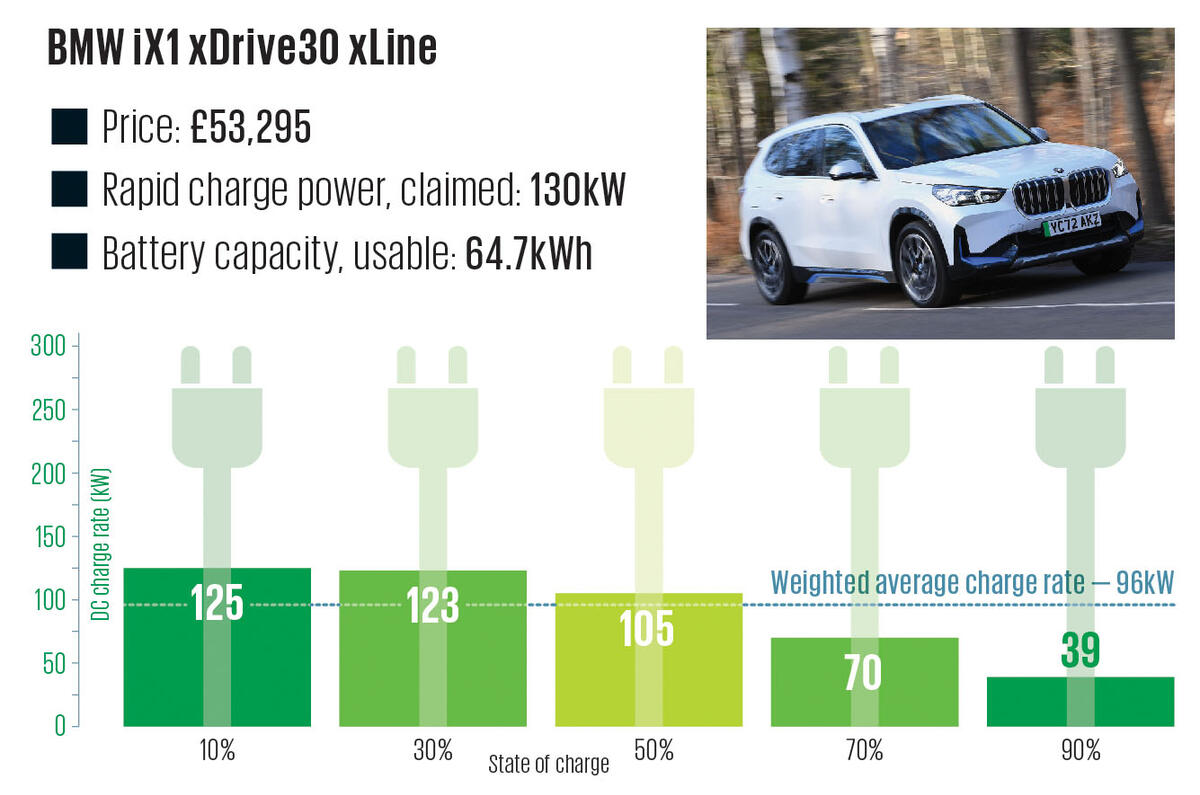
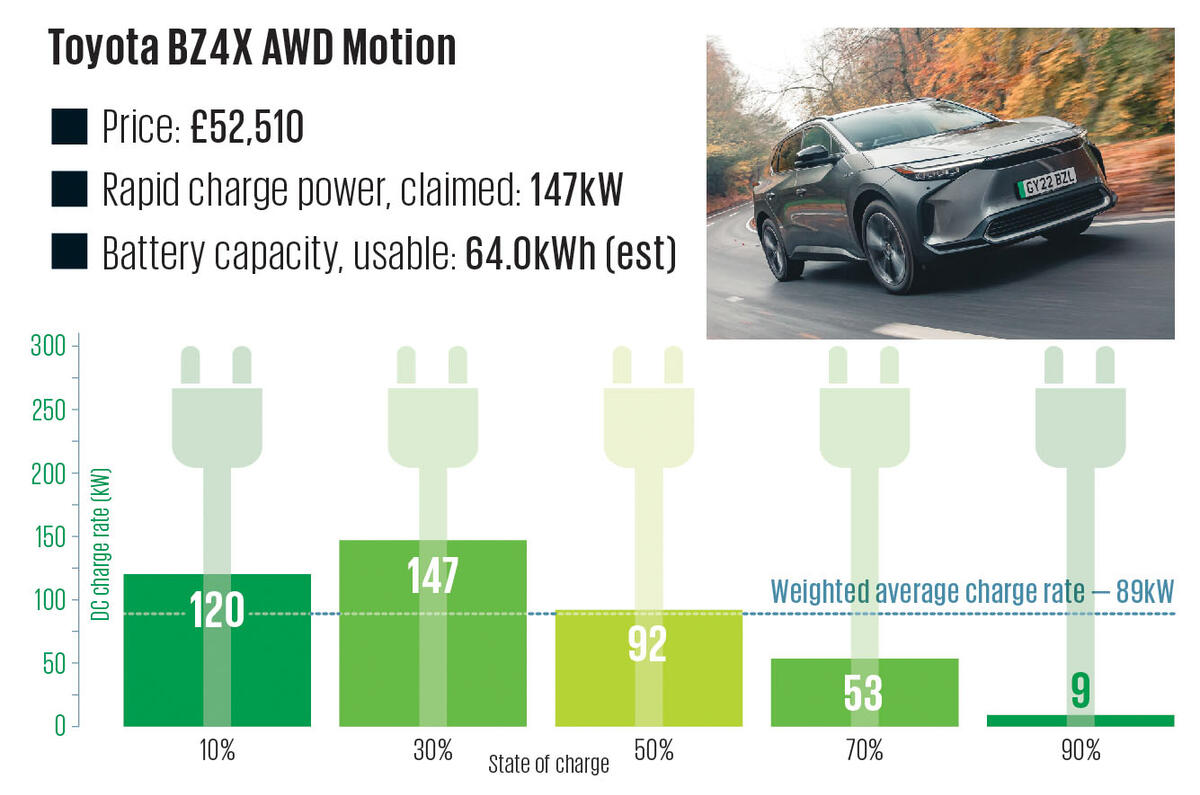
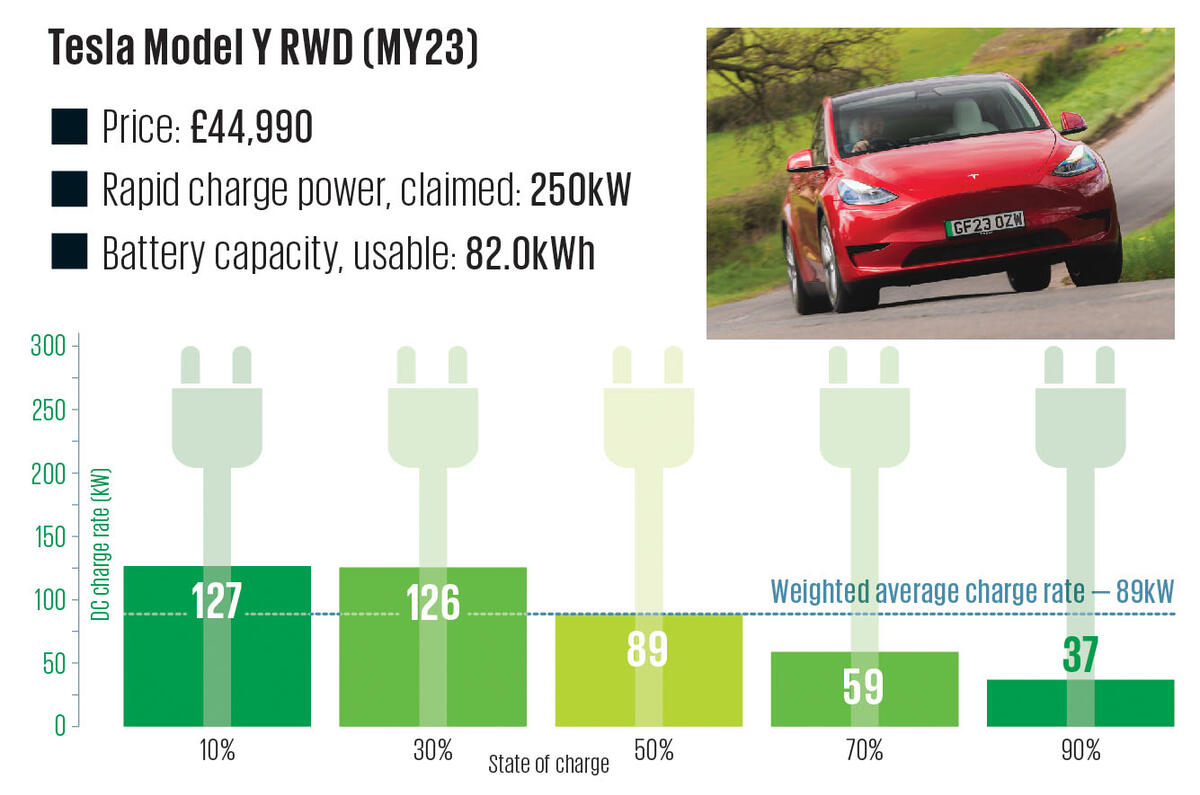
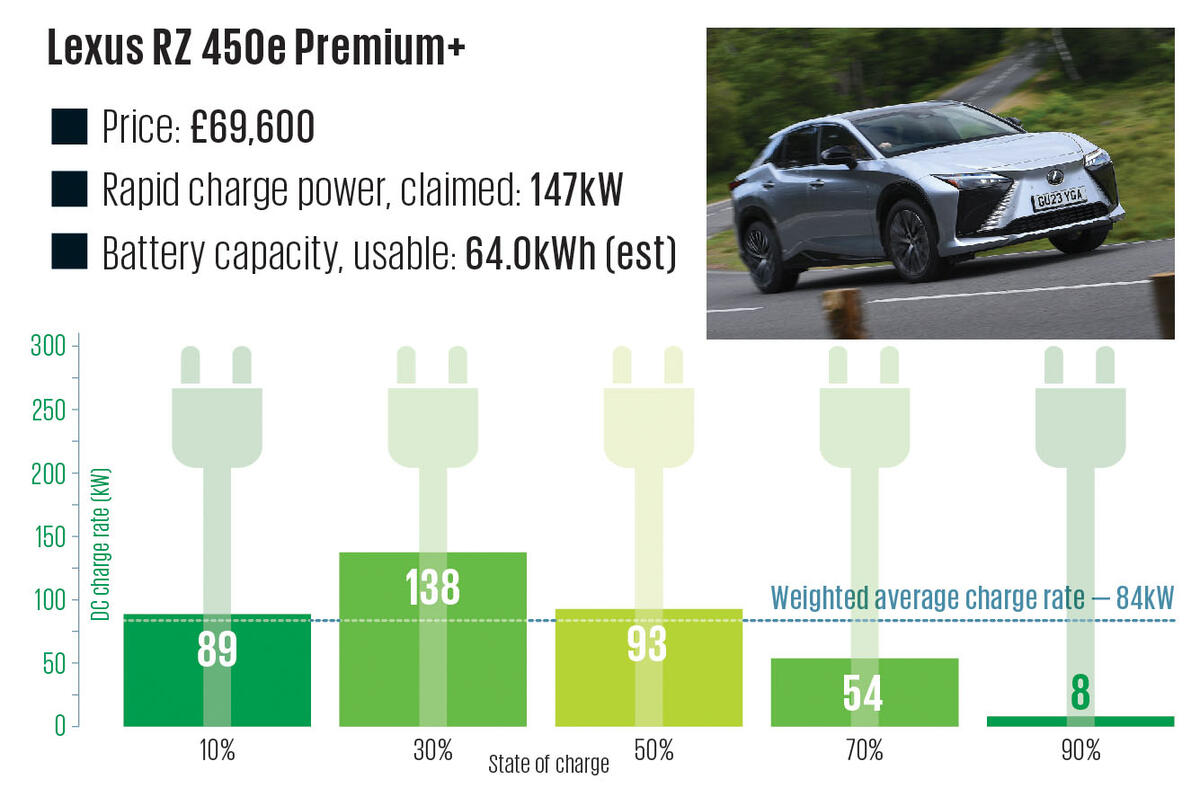
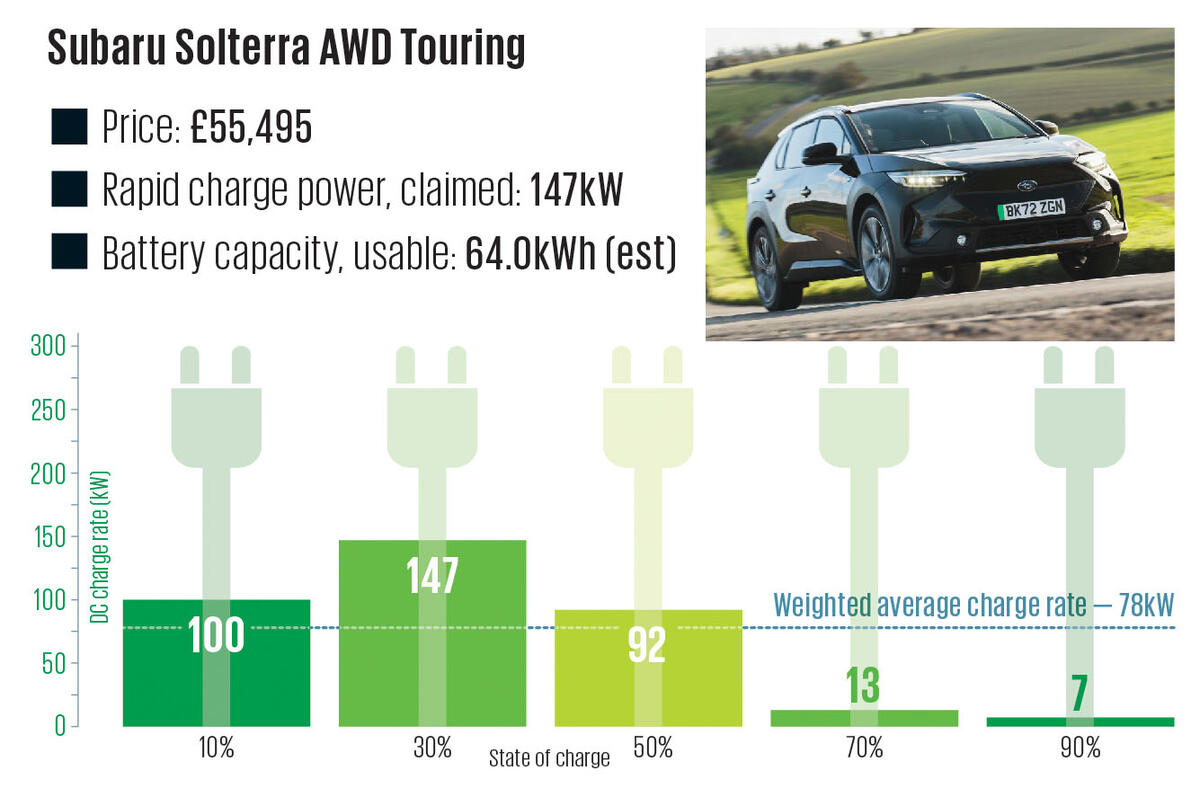

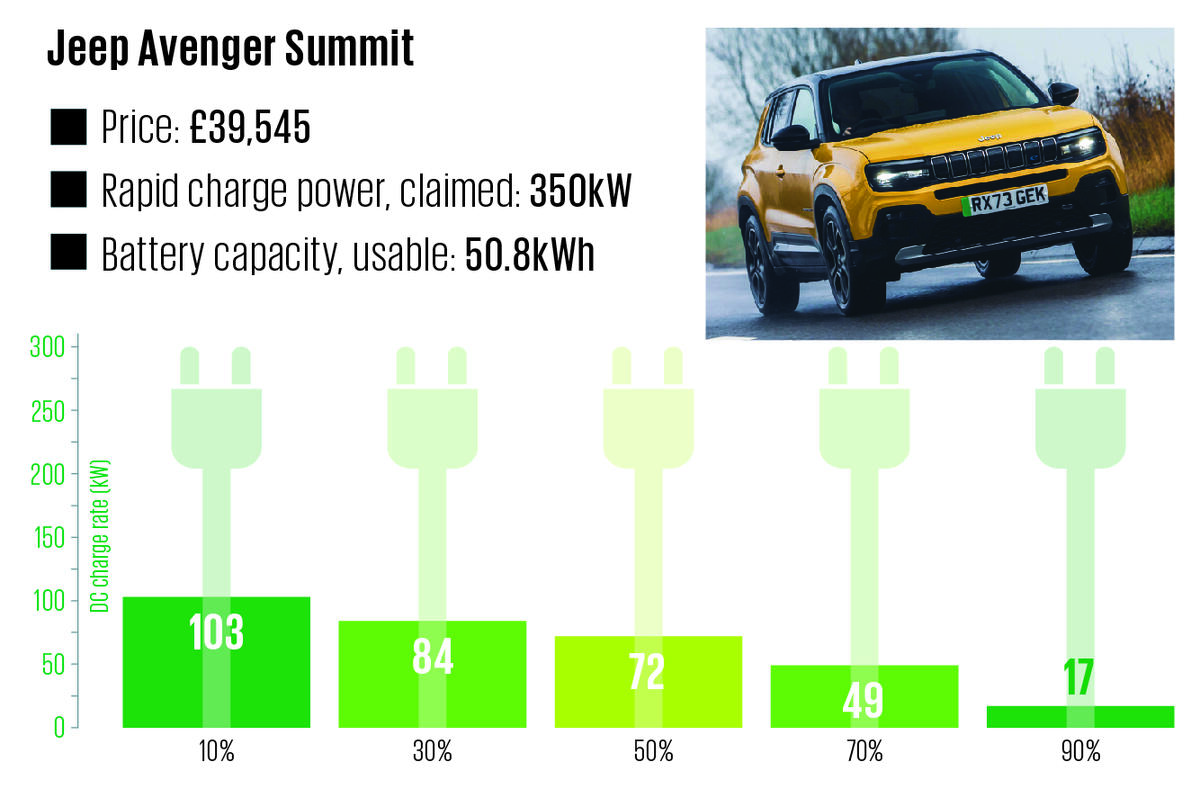

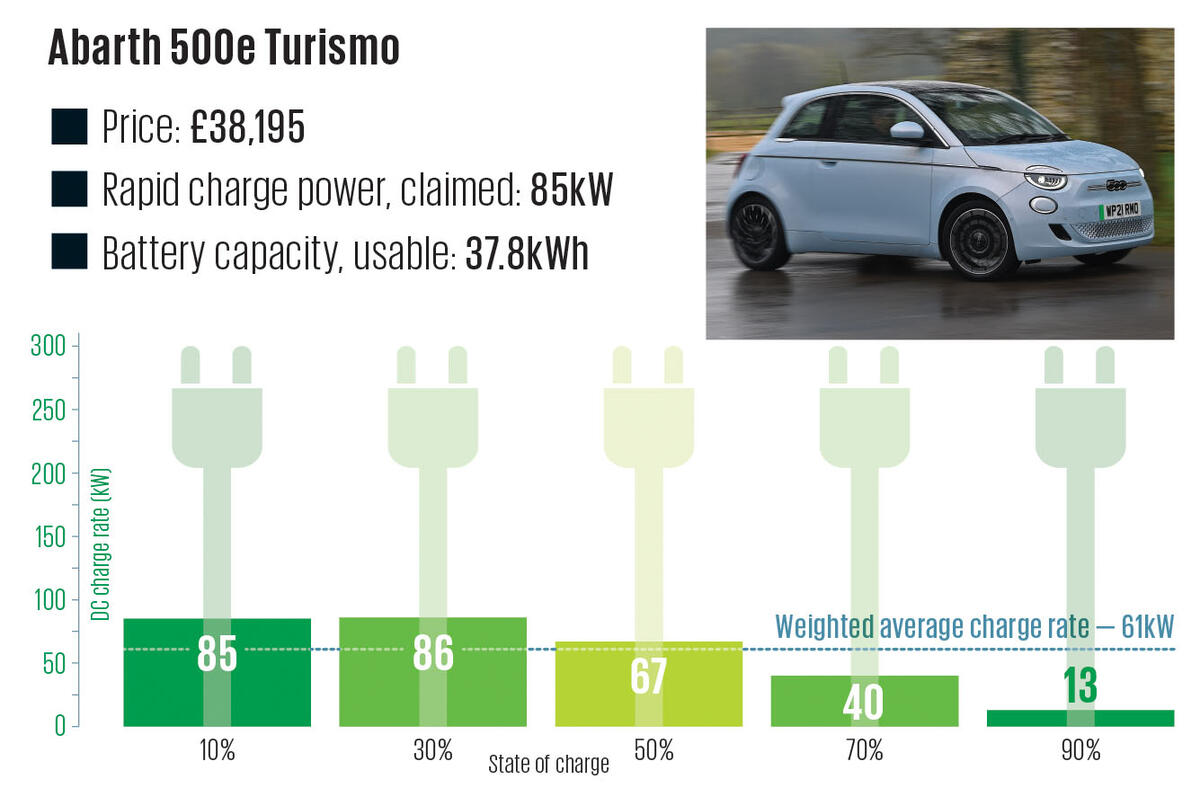


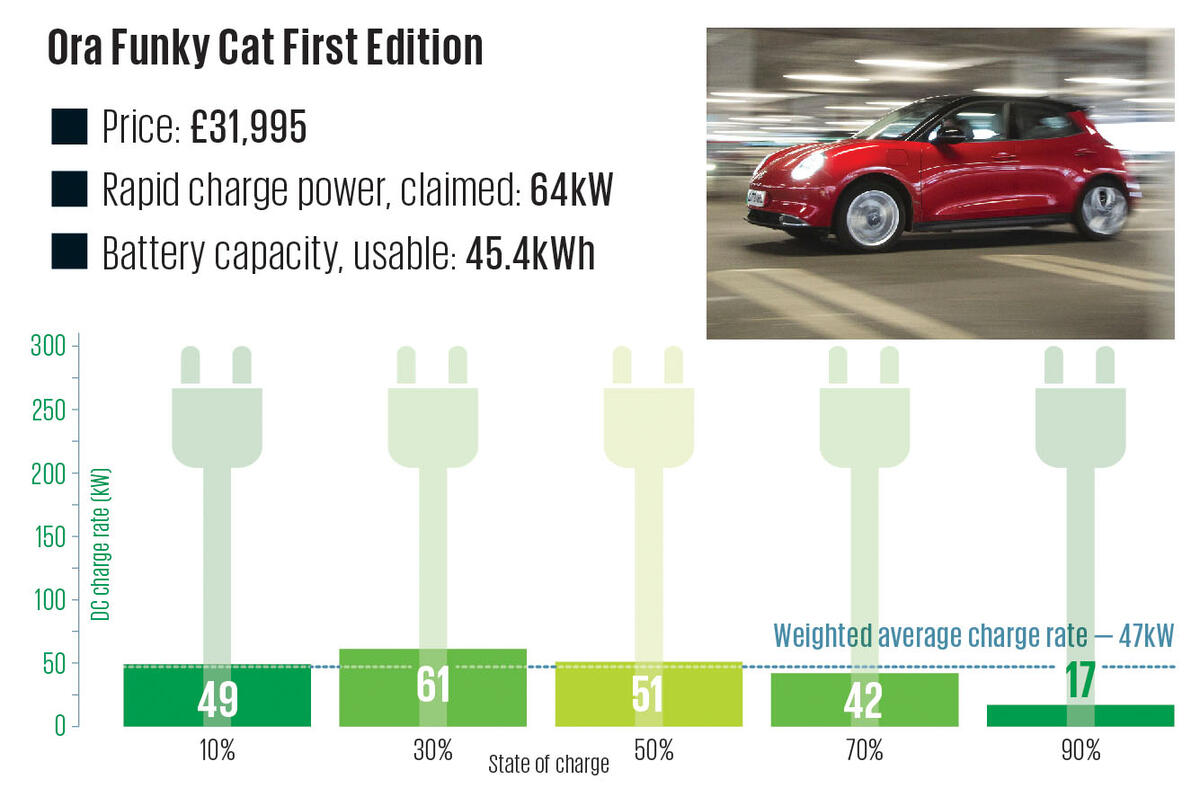
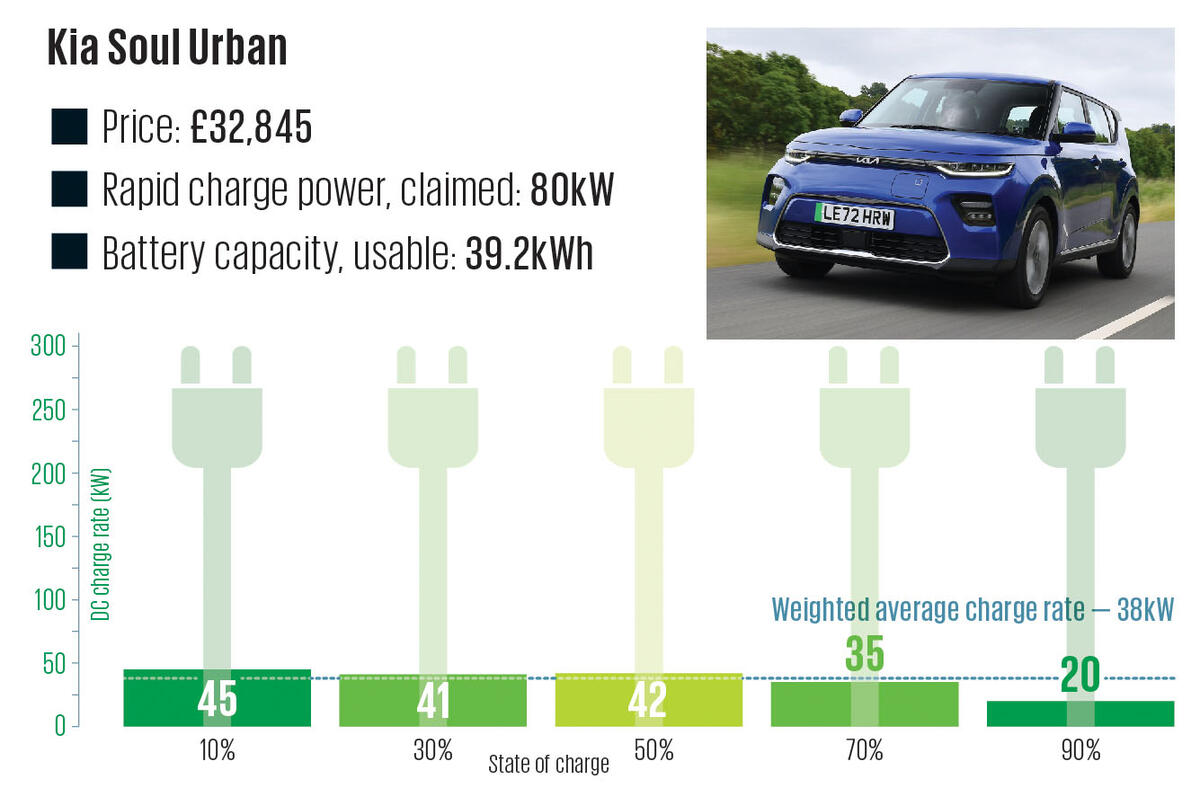
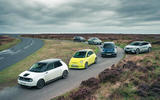
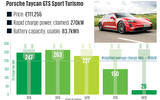
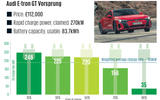
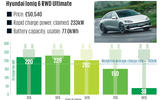
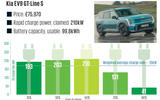
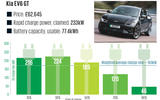
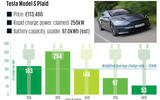
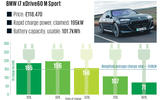
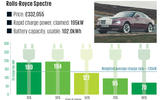
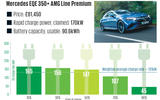
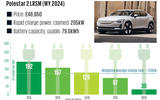

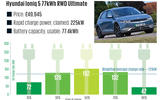
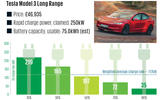
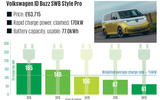
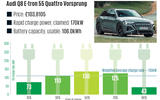
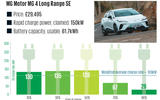

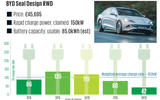
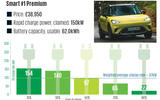
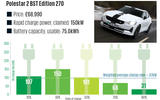
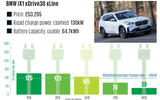
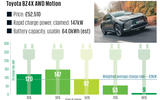
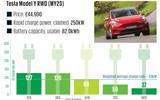
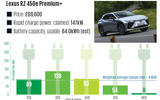
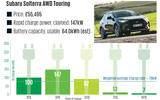
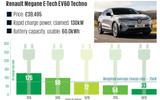

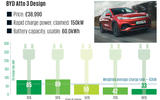

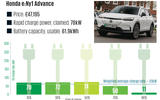

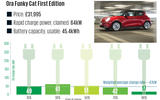
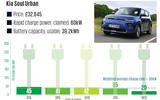



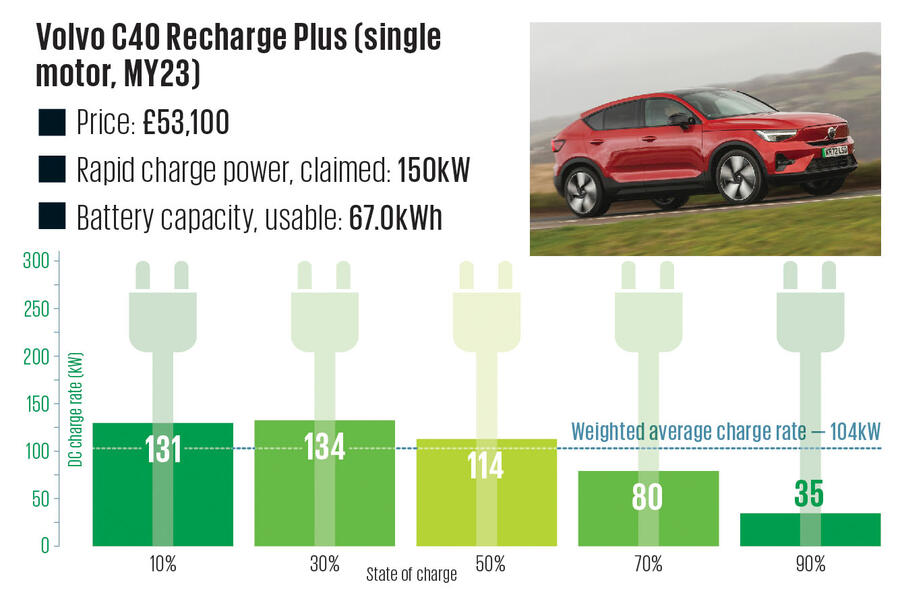
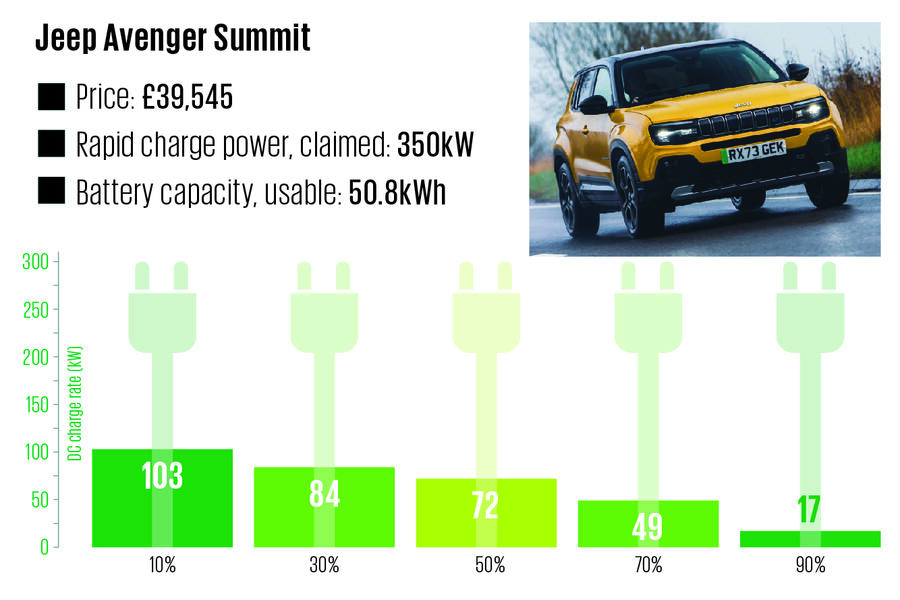





Join the debate
Add your comment
The issue is range anxiety.
Why don't you measure something more useful like "how long does it take to add 100 miles of range"?
You could do that at different criteria: 20% remaining or at 20 miles remaining.
Assume these charging times factor in the 50-90 minute wait for a charger due to them being taken/majority non-operable/incompatible/in de-rated mode/the wind is blowing in the wrong direction do they're on strike?
Well, having read all the posts below, there seems a lot of factors to get right to running an EV efficiently, as you guessed I'm not an EV owner yet, it's inevitable that I will be but the amount of stuff to remember and other than better for the environment and cost saving, although that will go up to replace lost ICE Taxes, it almost makes Ev's a pain, the weather, pre heating the battery and so on, a breakdown on running an EV for a year would help also.
Not remotely.
Buy a bog-standard Toyota Landcruiser. You can ignore all the considerations you mention - and just put fuel in and maintain at the bare minimum prescribed by Toyota. Untroubled motoring for decades.EV maintenance costs are demonstrably higher - the figures are readilly available.